
Admin
-
Posts
7,448 -
Joined
-
Last visited
Content Type
Profiles
Forums
Events
Store
Gallery
Community Map
Posts posted by Admin
-
-
Hello NinZee,
Welcome to The Motorbike forum. Please feel free to browse around and get to know the others. If you have any questions please don't hesitate to ask.
Why not tell us a bit about yourself too.
-
Hello Darth Moron,
Welcome to The Motorbike forum. Please feel free to browse around and get to know the others. If you have any questions please don't hesitate to ask.
Why not tell us a bit about yourself too.
-
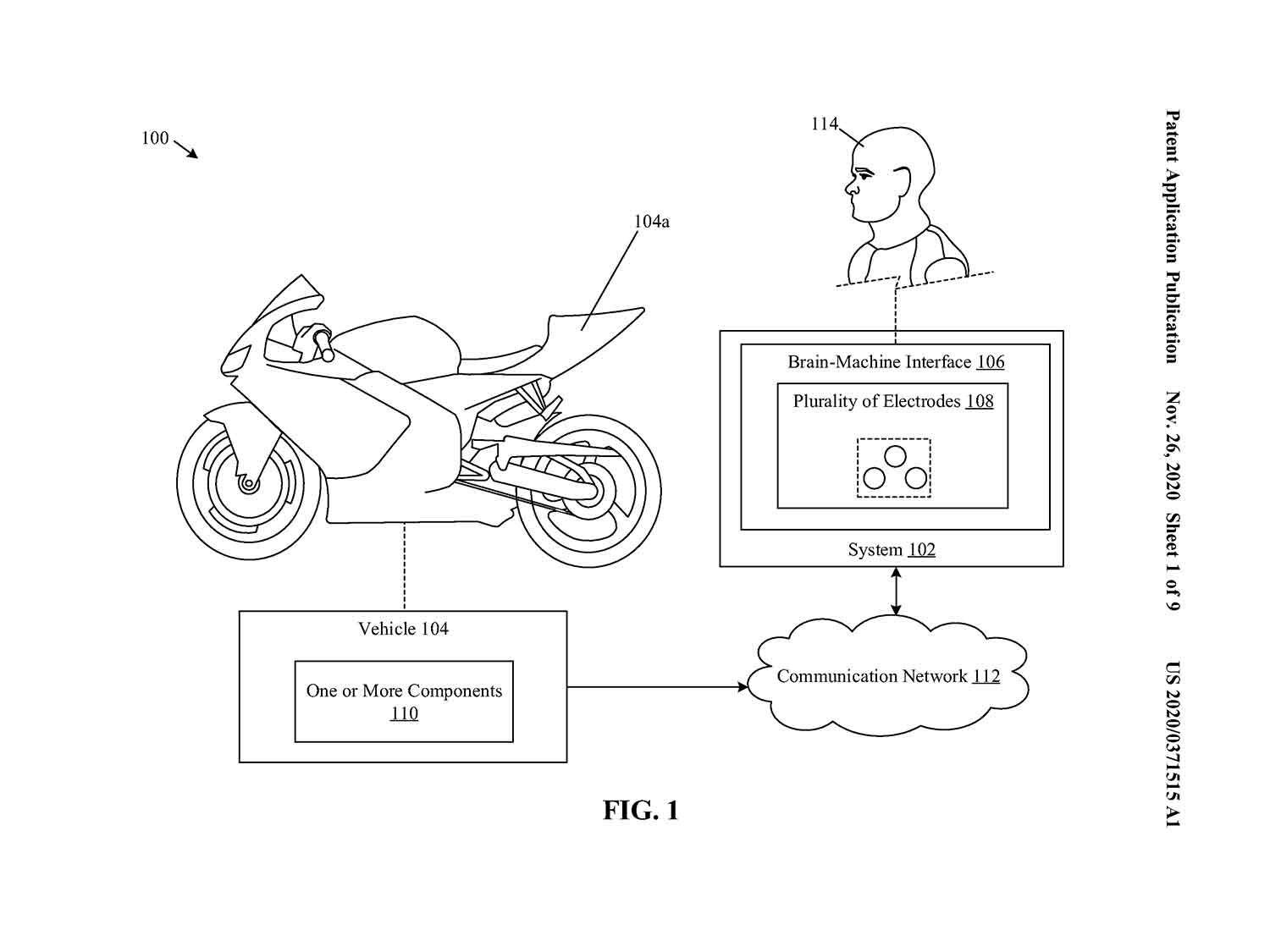
Will Honda’s brainwave detection patent lead to more seamless rider safety systems? (US Patent Office/) It might sound more science fiction than science fact but Honda has filed a patent showing that it’s working on a brainwave-detection system to help future motorcycles know their riders’ intentions. Why? So that on-board safety systems can ensure the bike does what you want even if your control inputs are clumsy.
The new patent application comes from Honda’s Los Angeles-based R&D Americas facility and aims to improve the way man and motorcycle interact. It might seem futuristic, but in a world where Elon Musk is developing brain-implant ‘neurotechnology’ that gives a direct connection between mind and computer (via his Neuralink company), the idea of a bike that can read your thoughts might not be so far-fetched.
Related: Kawasaki To Employ Radar-Assisted Safety Systems

The brain-machine interface tech would seek to send riders’ brainwaves to the bike’s onboard computer. (US Patent Office/) The principle of Honda’s idea is simple enough, even if the actual technology involved is at—or even beyond—the current bleeding edge of what’s possible. In short, you wear a helmet with built-in electrodes that can pick up brainwave signals and feed them to a “Brain-Machine Interface” computer that interprets them and then sends them on to your bike.
The motorcycle itself is much the same as any of the latest, rider-aid-packed models. The integrated suite of accelerometers, an inertial measurement unit (computing lean, yaw, and pitch), an electronic throttle, traction control, and computer-controlled ABS brake system is no different than what you’d find on a host of current machines. The only notable addition mentioned in the patent is a sensor measuring steering angle and an actuator to move the steering itself if the computer decides it’s necessary.
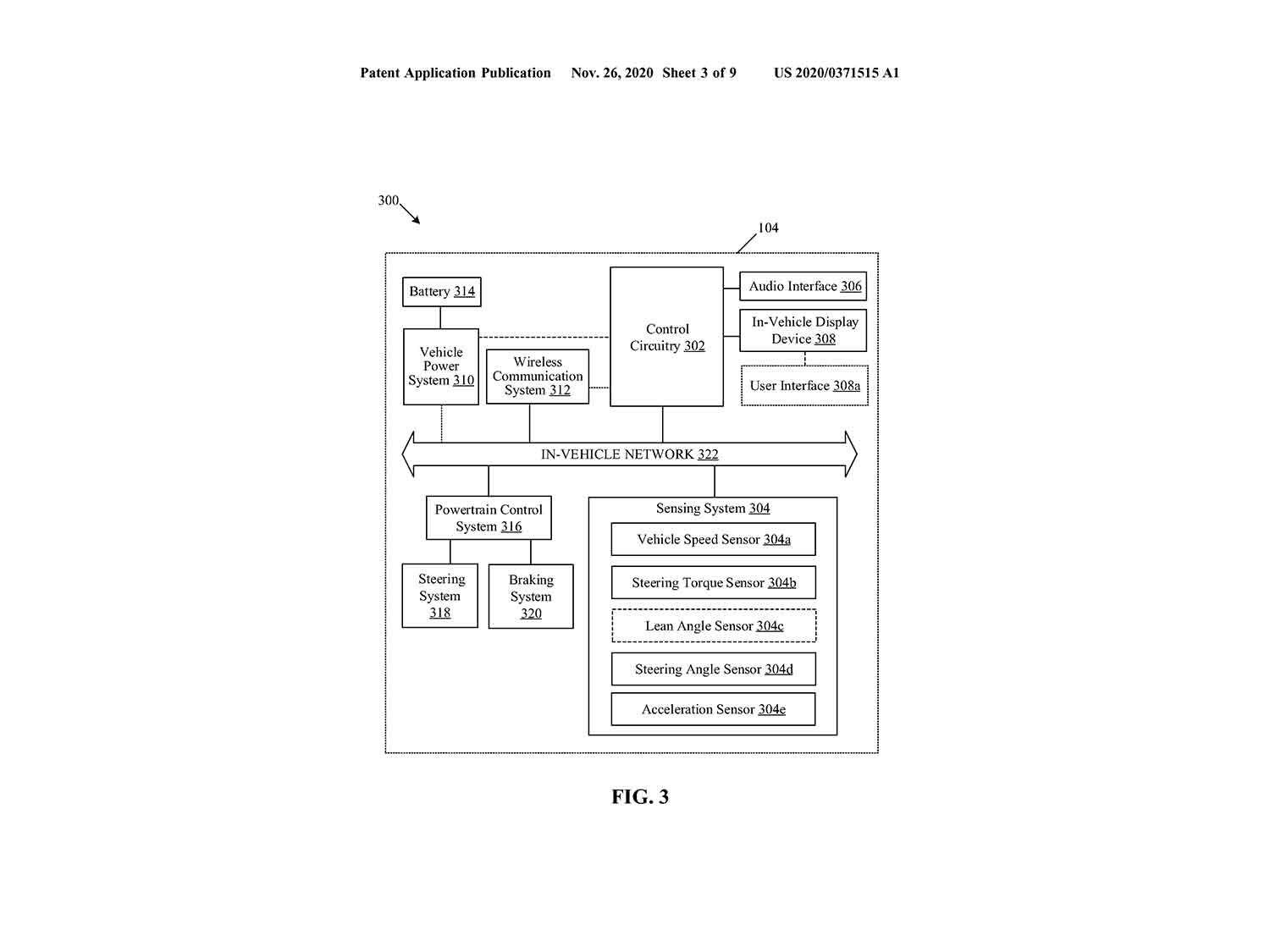
The motorcycle portion of the equation would be outfitted with many of the latest electronic rider-assist systems already in use. (US Patent Office/) Impressive though they are, the latest rider-assist systems are still essentially limited by the fact that they can only react to what they sense, relying on programming to try to interpret the rider’s inputs and deliver what he or she wants. That’s why you still need to pre-select settings for things like traction control and ABS to tell the bike how early you want it to intervene and by how much. By adding sensors that can literally read your mind, the same rider-assist systems have the potential to be much more effective.
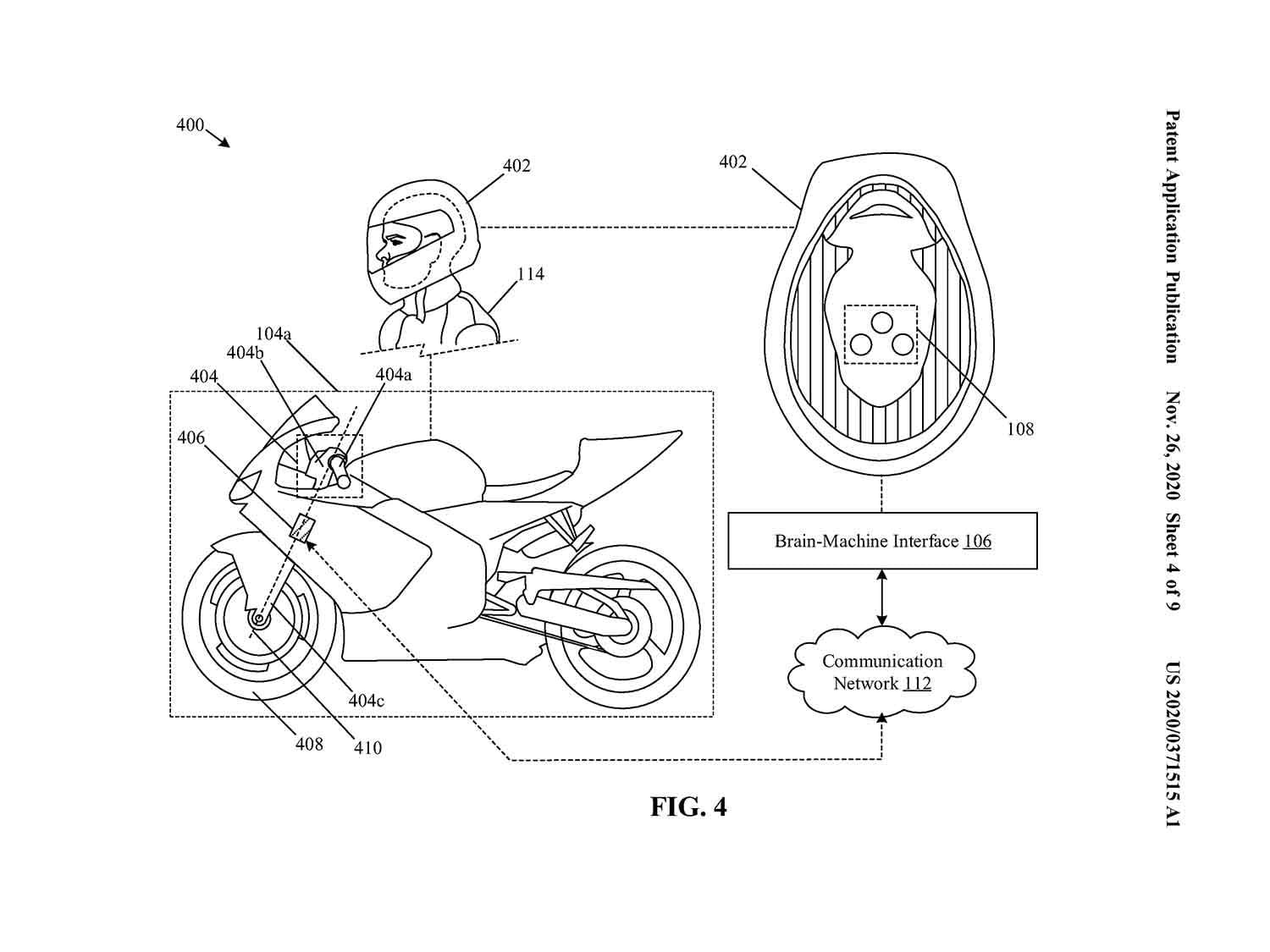
A helmet with built-in electrodes would pick up brainwaves and send them to the bike’s onboard computer for interpretation. (US Patent Office/) Honda actually uses the wheelie as its main example of a rider’s mind control over the bike. After all, we can all picture an impressive wheelie, but even if you know the theory of how to do it, actually pulling one off isn’t straightforward without a lot of practice.
The patents say that the bike could sense inputs, including brainwaves, that “may be indicative of the user’s intent to perform the wheelie” and actually assist you in doing it by taking over control of various aspects of the bike automatically.
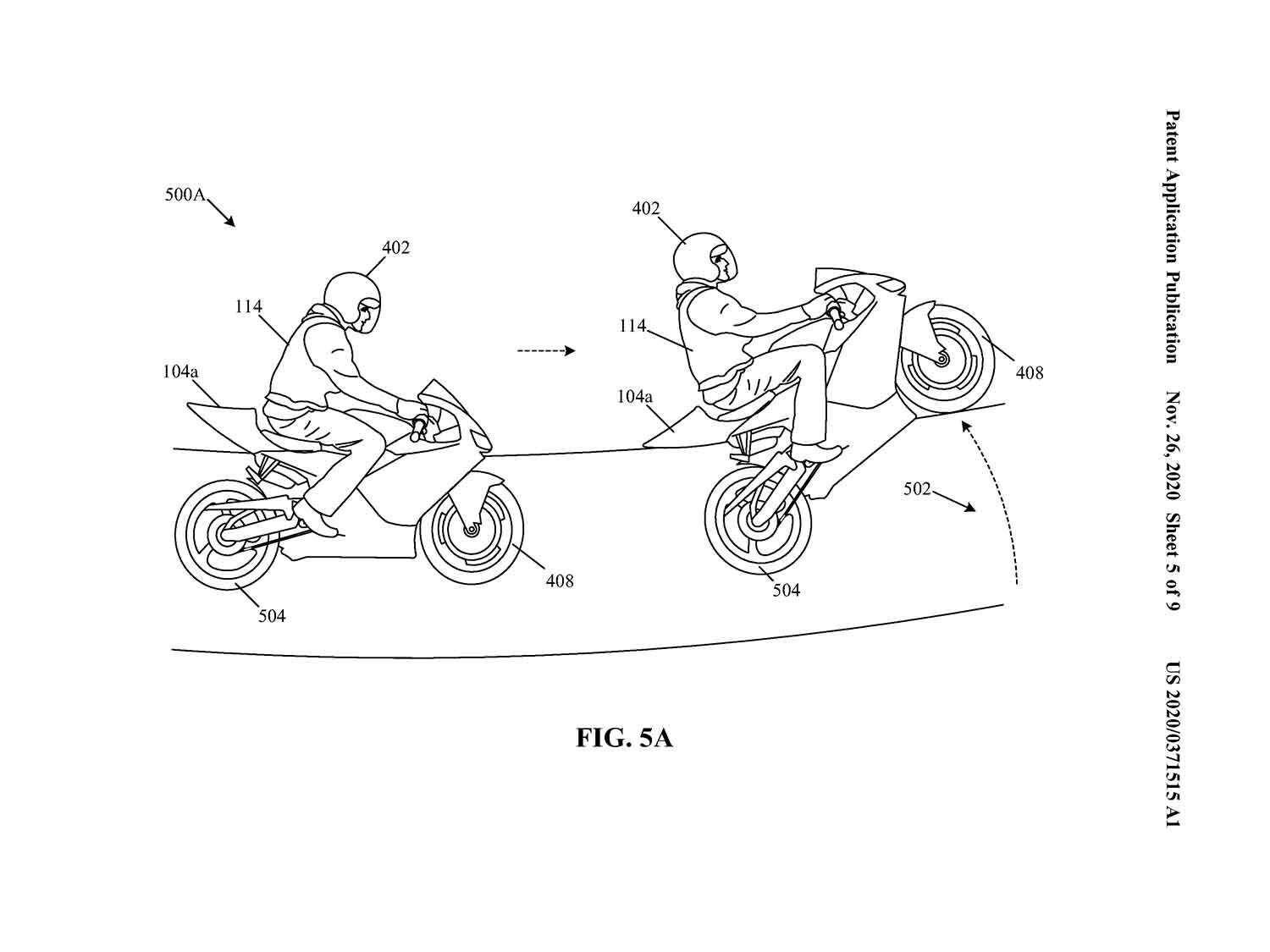
Wheelies via mind control? It maybe become a possibility in the near future. (US Patent Office/) Other passages explain the process: “Once controlled, the throttle may be increased to cross a threshold value and immediately clutches may be pulled to disengage transmission gears. Further, as engine revolution increases, the clutches may be immediately released by a certain amount (e.g., “80%”) while the throttle is controlled. This may pull the front wheel to lift up while the rear wheel stays on the ground…”
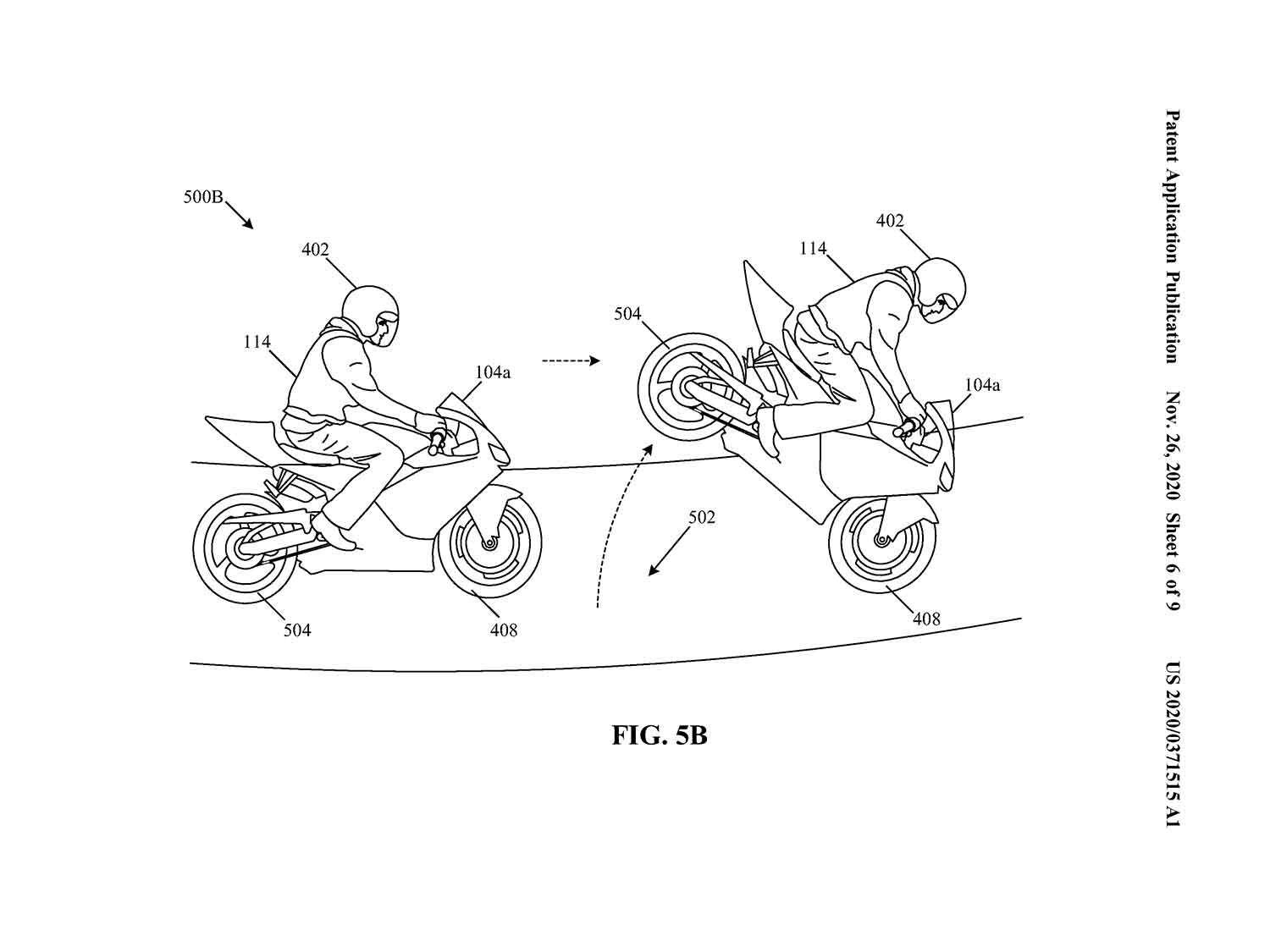
Once the computer takes control it can modulate various systems to complete the operation safely. (US Patent Office/) While a bike that can pull off a perfect wheelie regardless of the rider’s skill might not be an obvious benefit to road safety, and is sure to rile everyone who’s put in the hard hours learning how to do one unaided, there are bigger implications from the system.
Honda’s own Riding Assist and Riding Assist-E concept bikes have shown that the firm is capable of making self-balancing, semi-autonomous motorcycles. By combining that technology with a system that can accurately interpret a rider’s intentions, it should be possible to create a bike that makes up for any deficiencies in the rider’s skill while still doing exactly what he or she wants it to – giving all the pleasure of riding but eliminating many of the risks.
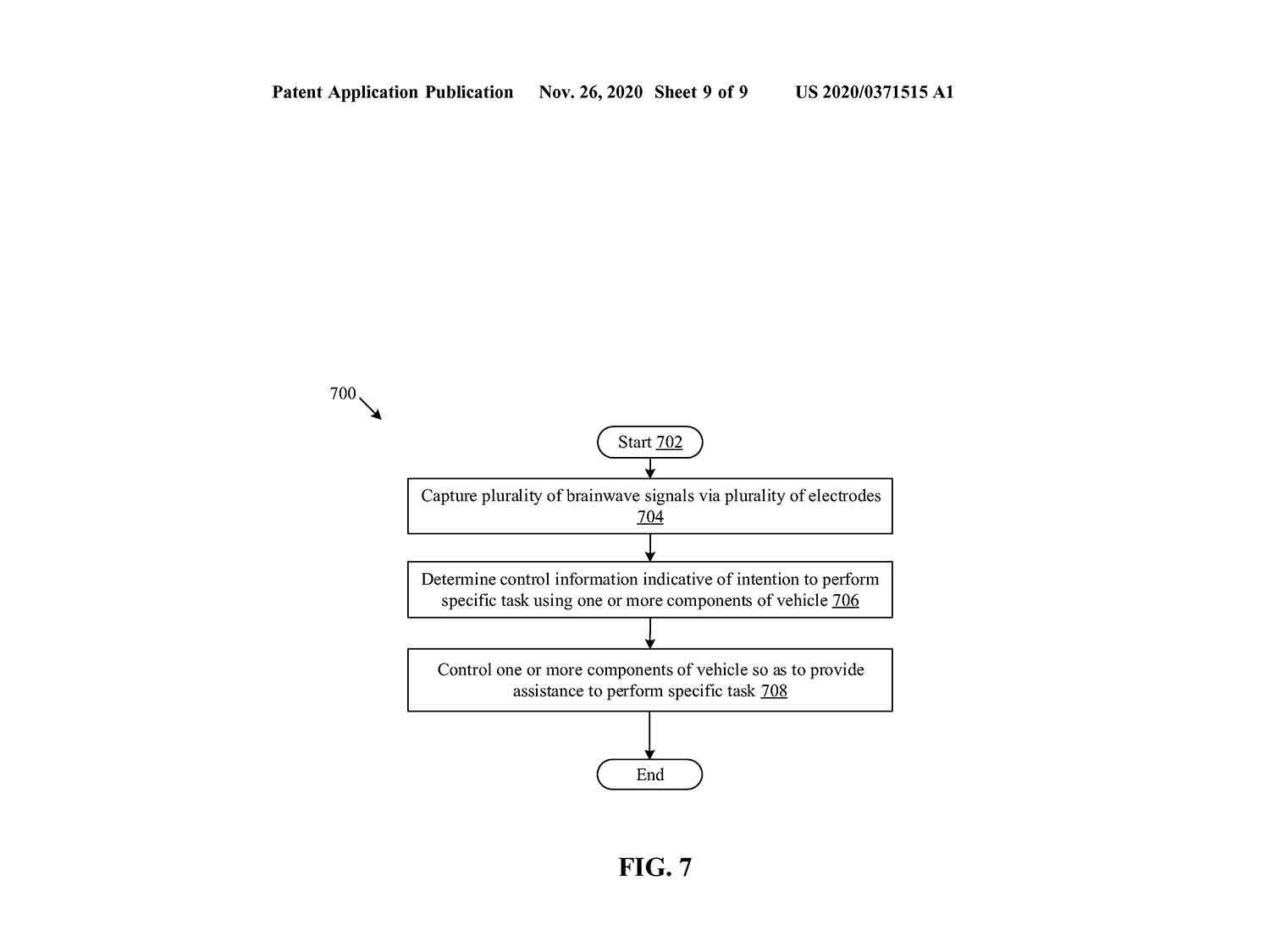
Acting to interpret the rider’s intentions via the ‘brain-machine interface’ team up to offer assistance. (US Patent Office/) Brainwave-operated control systems are already subject to plenty of military research, with DARPA and others working on methods that could control certain fighter jets systems by thought alone—the sci-fi of “Firefox” brought to the real world—and to create thought-controlled prosthetics for paraplegics and amputees. It might be in the early stages but there’s every indication that direct thought control is going to become increasingly common in future, even on motorcycles.
-
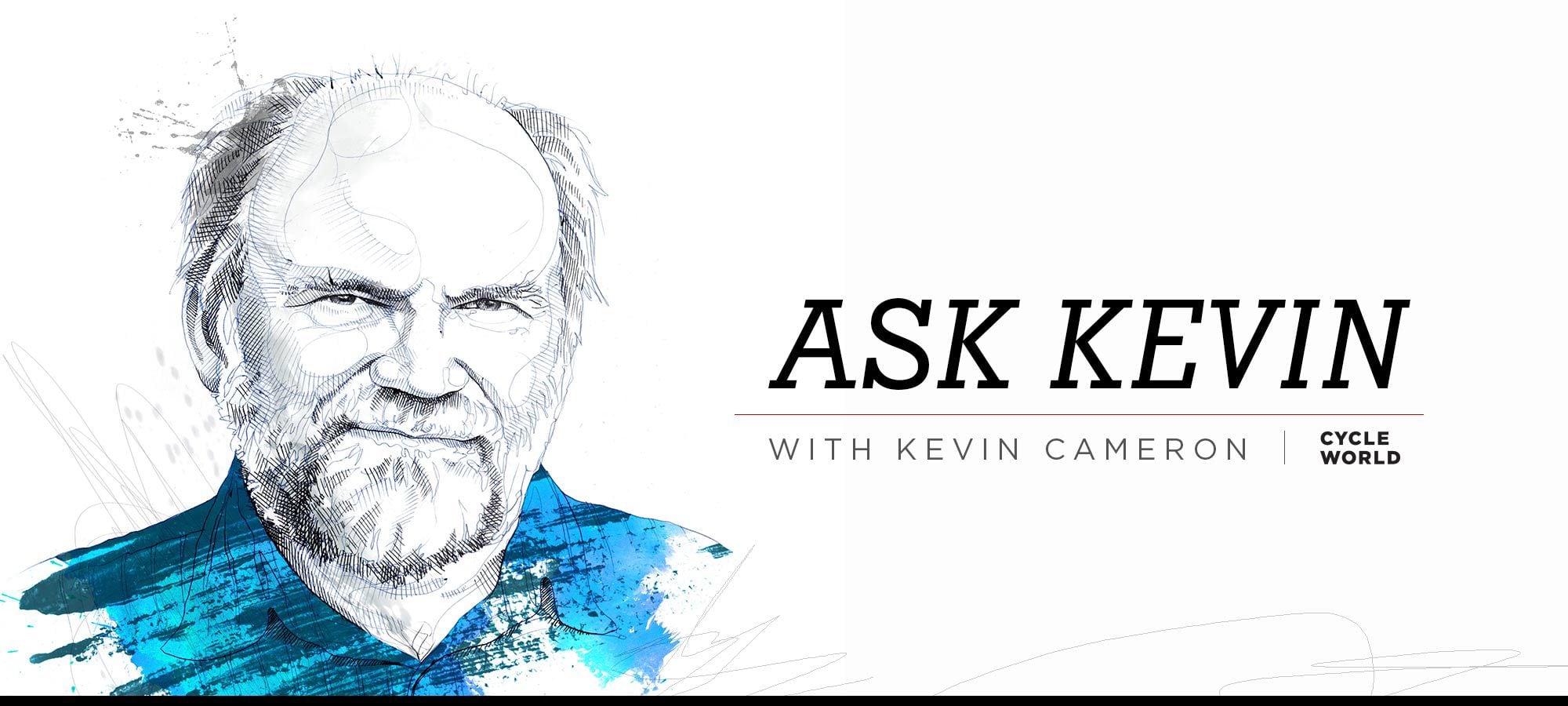
Kevin Cameron (Robert Martin/) I’ve written about this before but it’s a message that bears repeating.
We live in a time of marvelous, highly capable motorcycles in every category, but the old tradition of at-home maintenance has grown thin, that of dads who on certain Saturdays confidently changed the oil in the family car’s engine, or replaced noisy wiper blades, or changed a fan belt. More than one woman has told me, with a certain ironic look, that “Today’s guys know mainly two things: How to do whatever it is they do at work, and how to watch sports on TV.”
When, during the 1970s and ’80s, I modified cylinders or machined heads for more compression for club racers, I wasn’t asked for carburetor jetting specs. When I’d offer, riders would say, “I’ll handle it.” During the ’90s that changed, and so did the population of people going racing. The older “man in a van with a plan” was being replaced by box trucks filled with bikes that were increasingly professionally prepared. People picking up custom pipes or altered cylinders from me wanted carb jetting specs, and they wanted to be guaranteed their engines would never, ever seize. Eventually I stopped doing that work because a day was clearly coming when I would need something like doctors’ malpractice insurance.
How do you become comfortable with machinery? More people used to grow up on farms, where if you couldn’t fix broken equipment yourself, you did without. More people had manufacturing jobs at which they worked with machines; manufacturing is now down to 8 percent of the US GNP. The armed services were great places to become familiar with tools and equipment, but increasingly, service is now performed by manufacturer’s reps. My middle son, asked by his officer to round up a working mine roller, was told hands off—the maker’s reps were the only ones authorized to touch that equipment. When he bypassed the hydraulics and got one working, he was nearly in big trouble. Fortunately his officer showed up.
The spoken or unspoken message today: If you’re not an expert with documents to prove it, don’t dare touch equipment. You might wreck it! I don’t like to hear that, because there has never been a better time to take an interest in mechanical work. I’ve listed the reasons before. Here they are again:
- Huge numbers of used bikes, engines, parts, and sub-assemblies are easily available, cheap, on the Internet. So cheap!<br/>
- Tool sets in fitted plastic carrying cases are also cheap and can be at your door tomorrow.<br/>
- Illustrated service manuals exist and are for sale, also arriving tomorrow.<br/>
- If you get stuck, you have hundreds or thousands of potential online colleagues on brand-and-model forums who have hit the same problem you have, and they have uploaded their solutions, often with video.<br/>
Yes, you need a place to work with decent lighting and heat. A work surface. Containers for parts. A drain pan for oil. People do good work in all sorts of improvised work areas.
You can start with easy stuff like an oil change (the spec for oil and filter is in your owner’s book). Or you can adjust hand and foot controls to suit yourself. Ever get a cramp in your ankle from trying to keep from pressing a brake pedal that’s set too high? Annoyed by excessive slack in a throttle or clutch cable? Fixing these things is common sense.
Yes, there’s fear, because things are unfamiliar at first. When I was seven, my mother had a worn-out car engine brought to the unused side of our two-car garage. It took me considerable staring time to get over how strange it was, up close. Andit filthy with leaked oil and caked-on road grit. Gradually I got used to it, as I would also to clocks and watches. Lots of just staring until the sense began to emerge. Finally I began to unbolt things and stare at them, too. I was in new territory. Teachers don’t teach so much as they create situations in which people can’t help but learn. Teaching yourself teaches best, because the knowledge gained is all yours.
Twenty years later I found myself still staring at parts when new race bikes arrived in the spring. I’d walk up and down with a cylinder or piston in my hands, staring, trying to see what was new, trying to make sense of it. I’d make bad instant coffee and walk and stare some more, sipping.
Two years ago Cycle World wanted some videos made of what’s inside a late-model sportbike engine. The not-exactly-princely sum of $150 summoned a 26,000-mile CBR600 engine from the teeming parts marketplace. Lots of people think nothing of laying out similar money to put a framed art print on their wall or go out to a nice dinner for two. Buy a used engine and treat yourself to the instructive experience of taking the thing apart, tracing out its systems, and getting familiar with all the parts and how they look. Your hands will become familiar with the forces involved in loosening fasteners (this is the origin of “common sense” in such matters). More staring, plus reference to a service book, brings everything within the range of human understanding.
-
Hello alex_from_JandS,
Welcome to The Motorbike forum. Please feel free to browse around and get to know the others. If you have any questions please don't hesitate to ask.
Why not tell us a bit about yourself too.
-
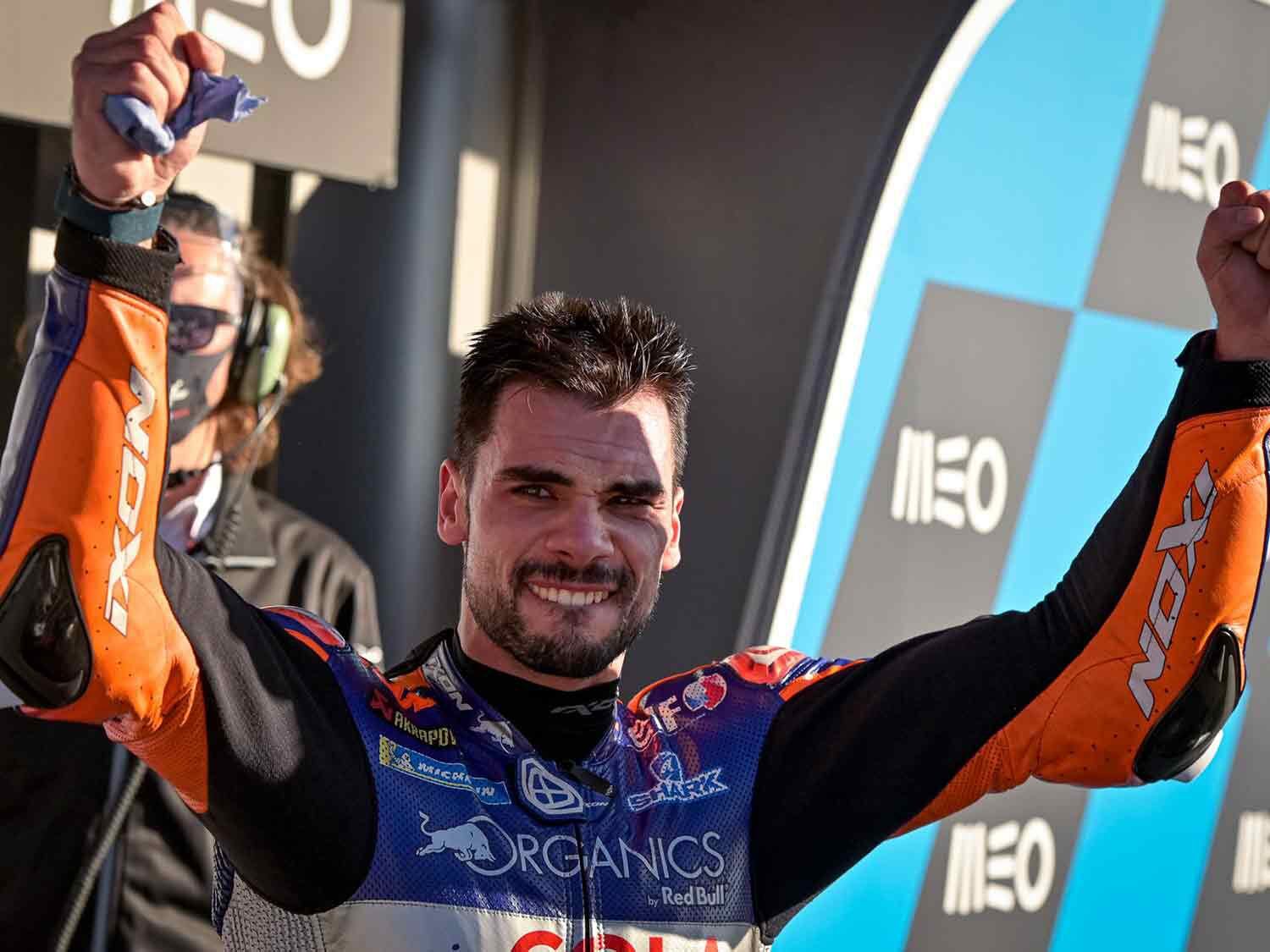
Miguel Oliveira took the win at Portimão. (MotoGP/) The top three finishers in the season-ending MotoGP of Portimão, Portugal, were all on satellite bikes—Miguel Oliveira topped the podium on a Tech3 KTM, Jack Miller on a Pramac Ducati, and Franco Morbidelli third on a Petronas Yamaha. All this year it has seemed that satellite teams have hit it right more often than the factory groups.
With Suzuki’s Joan Mir taking the 2020 MotoGP championship last weekend at Valencia 2, all that remained was the question of who could find a working combination for Portimão, a circuit new to the MotoGP paddock. Its ups and downs caused some riders to liken it to motocross, and another to find closest similarity to Laguna Seca, in Monterey, California. Although recently repaved, evidently presenting an abrasive surface that ages tires rapidly, both Andrea Dovizioso and Danilo Petrucci (both on Ducati) noted that bumps and “holes” remained numerous.
As so often, Maverick Viñales, the man of two moods, greeted Friday saying, “It’s been a long time since I enjoyed myself like this on the bike.” Oliviera topped FP1, saying, “I’m feeling really good and enjoying every moment on track, happy with every lap.” Miller, after qualifying third behind Oliveira and Morbidelli, would say, “I have been feeling good from the beginning.”
There had previously been a Portimão test in which MotoGP regulars were allowed to learn the circuit, but only on production bikes. On Saturday morning, Viñales’ fortunes nosed over as so often before: “…today we didn’t have the same feeling, especially when it comes to rear grip.
“Saturday was a disaster.” This has been Viñales’ oscillating trajectory so often in his career—the Fates smile upon him, only to deceive.
Yet in that same session, Miller and Oliveira remained strong as 1-2. Petrucci, starting a lowly 18th on a Ducati team bike, was finding hard going with his factory Ducati: “I…still can’t get a good feeling with the bike on this track.”
He described the production bikes they rode in the test as, “…softer and more flexible bikes, and that helps a lot. MotoGP bikes are made to go very fast but here there are bumps and ups and downs.”
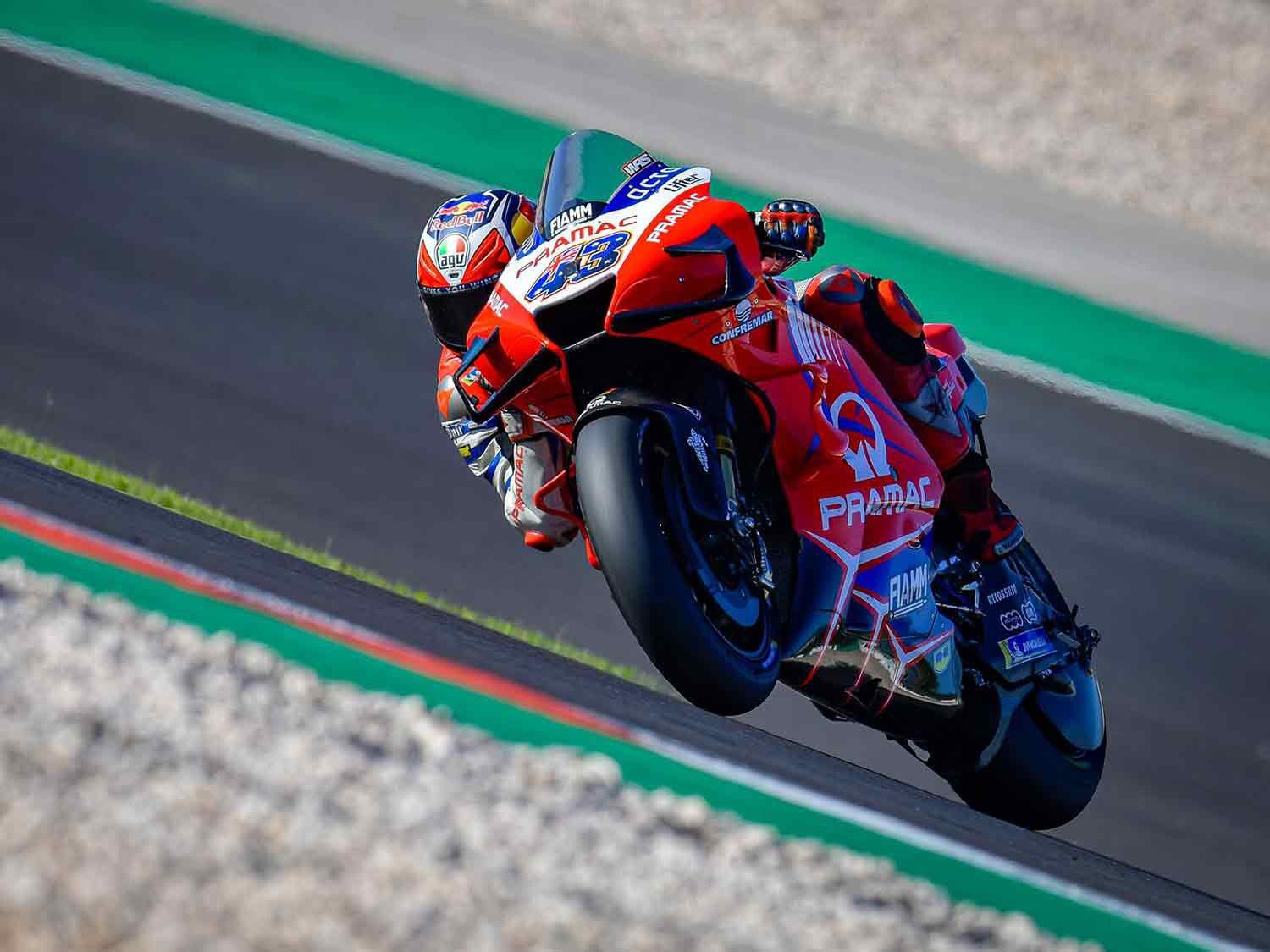
Jack Miller finished second in Portimão, but was nearly 5 seconds behind Oliveira. (MotoGP/) Years before, Ben Spies’ crew chief Tom Houseworth had described MotoGP bikes and their tires as being much stiffer than their World Superbike equivalents. Where there are bumps, that is a recipe for what MXers call “air time.” Tires generate zip for grip up above the pavement.
This put me in mind of things said about dirt-track car chassis setup. Yes, you can stiffen up the chassis like on an F1 car, but if you do, the suspension has to be exactly right or it doesn’t work at all. That is because the suspension must do the whole job. But with a more flexible chassis you get something that can work pretty well even if everything is a little off, because accidental chassis flex can compensate to a degree for an imperfect suspension setting. Could it be that MotoGP bikes are in general too specialized, too dependent upon a high level of pavement smoothness?
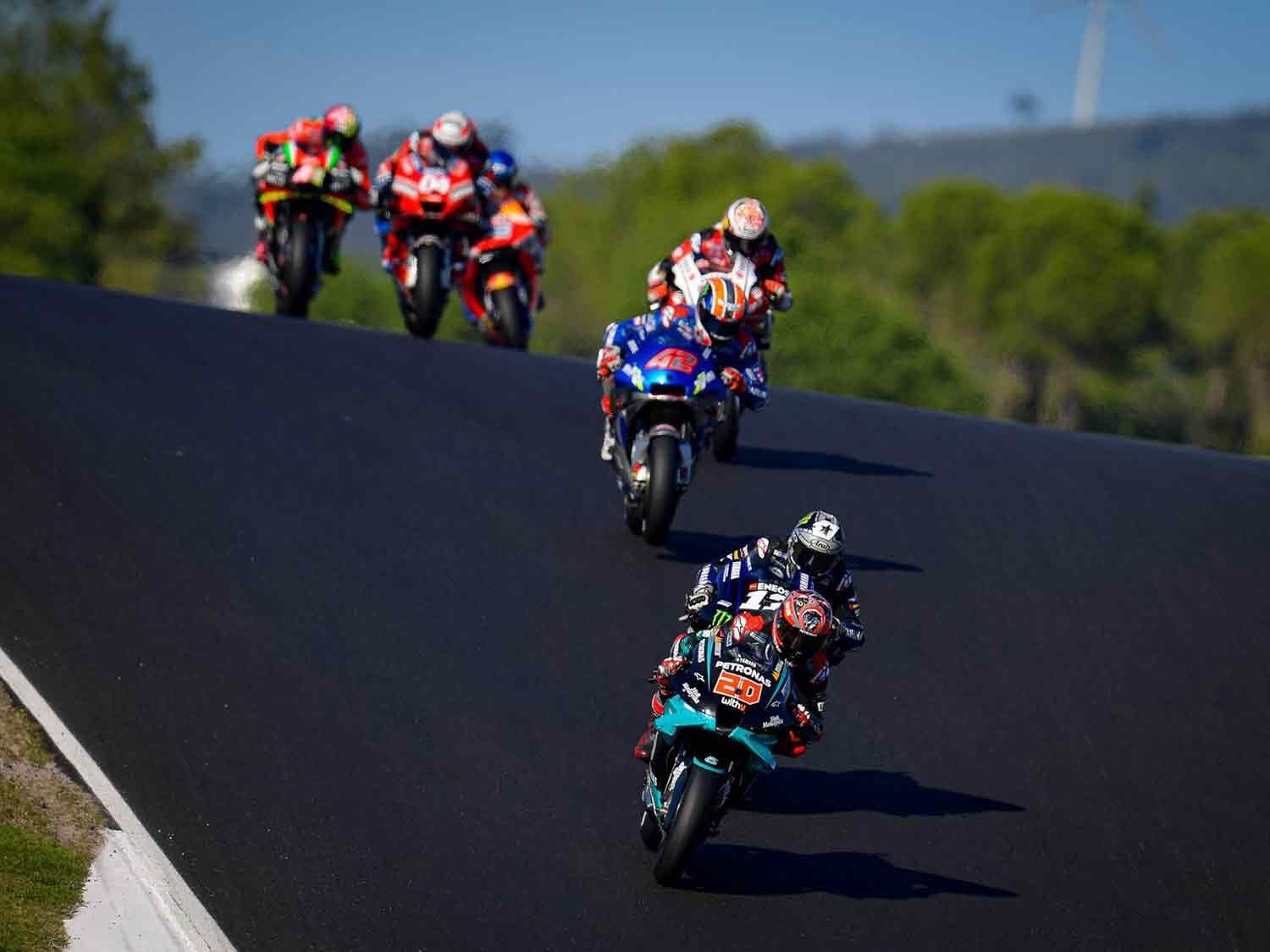
The undulations and bumps of Portimão made setup difficult for the super-stiff MotoGP bikes. (MotoGP/) In the race, Oliveira was master of ceremonies and pulled away. Miller said, “He went away so fast from me and Franky (Morbidelli) that the win was pretty much off the table about two laps in.
After his win he said, “It was long! … I didn’t want to look at the board for the first three laps. I just wanted to do my pace and my lines and try to see if anyone would go for a lunge on the inside.”
But he was alone.
“After FP4 I realized I had something more. I pushed from the start without looking back, but managing the tires and the advantage in the final laps was not easy.”
By lap 21 he led by 4.597 seconds.
The drama was behind him: a resumption of the Morbidelli-Miller battle which Morbidelli had won at Valencia 2. This time the finish was reversed as Miller-Morbidelli.
About his own setup, Miller said, “…it’s a challenge to work out your setup and where you might have to sacrifice on one corner to make the bike better for others. I’ve really found my groove again with the bike in the last few races…”
Morbidelli, too, had found Oliveira unapproachable: “(He)…had something extra today and we weren’t able to follow him.”
Dovizioso, leaving the Ducati team, fought through to sixth place, which is where Ducatis were finishing when he first came on the scene. Cal Crutchlow, also saying his goodbyes, finished 13th after a strong fourth in qualifying. I will miss the education both have given me in their words.
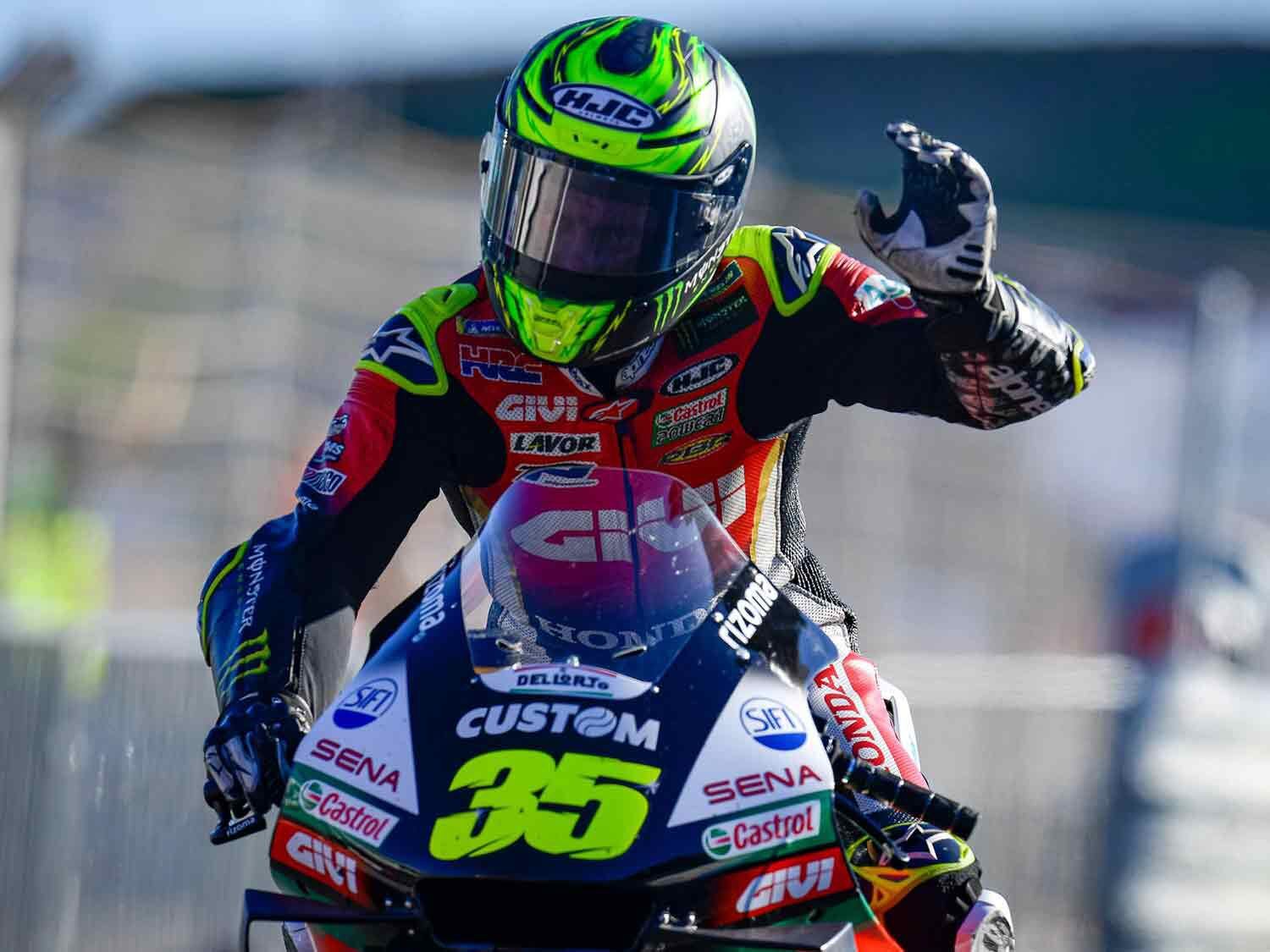
Cal Crutchlow finished his final MotoGP race in 13th. (MotoGP /) This year results have often seemed more like a lottery than a result of discoverable cause and effect. It’s tempting to just accept randomness in thoughts like: “Yamaha is out of it, except for a strong Morbidelli and sometimes Quartararo. Ducati is out of it, except for Miller, who seems to have some grasp of his fate. KTM is at last solidly on its way (three wins this year, two bikes in the top five today), but Honda must for the moment be content with the occasions when Nakagami or Alex Márquez has a good day and stays upright. Will Marc Márquez bring back the past, or will time’s arrow have flown on? Unknowable, so 2021 will see what Pol Espargaró can do as a hedge. Can Yamaha break out of its comfortable years of having nearly enough rear grip in the spring and not nearly enough in the fall? Will Ducati continue its fascination with braking stability and acceleration, to the exclusion of grip at the apex? Will Suzuki, the present master of all-around performance, emerge as a dominant force in 2021?”
As the Japanese manufacturers focus ever-more tightly on their Asian markets and backpedal in the West, the push and shove of sales competition is heating up Europe. That competition is the only good reason to race.
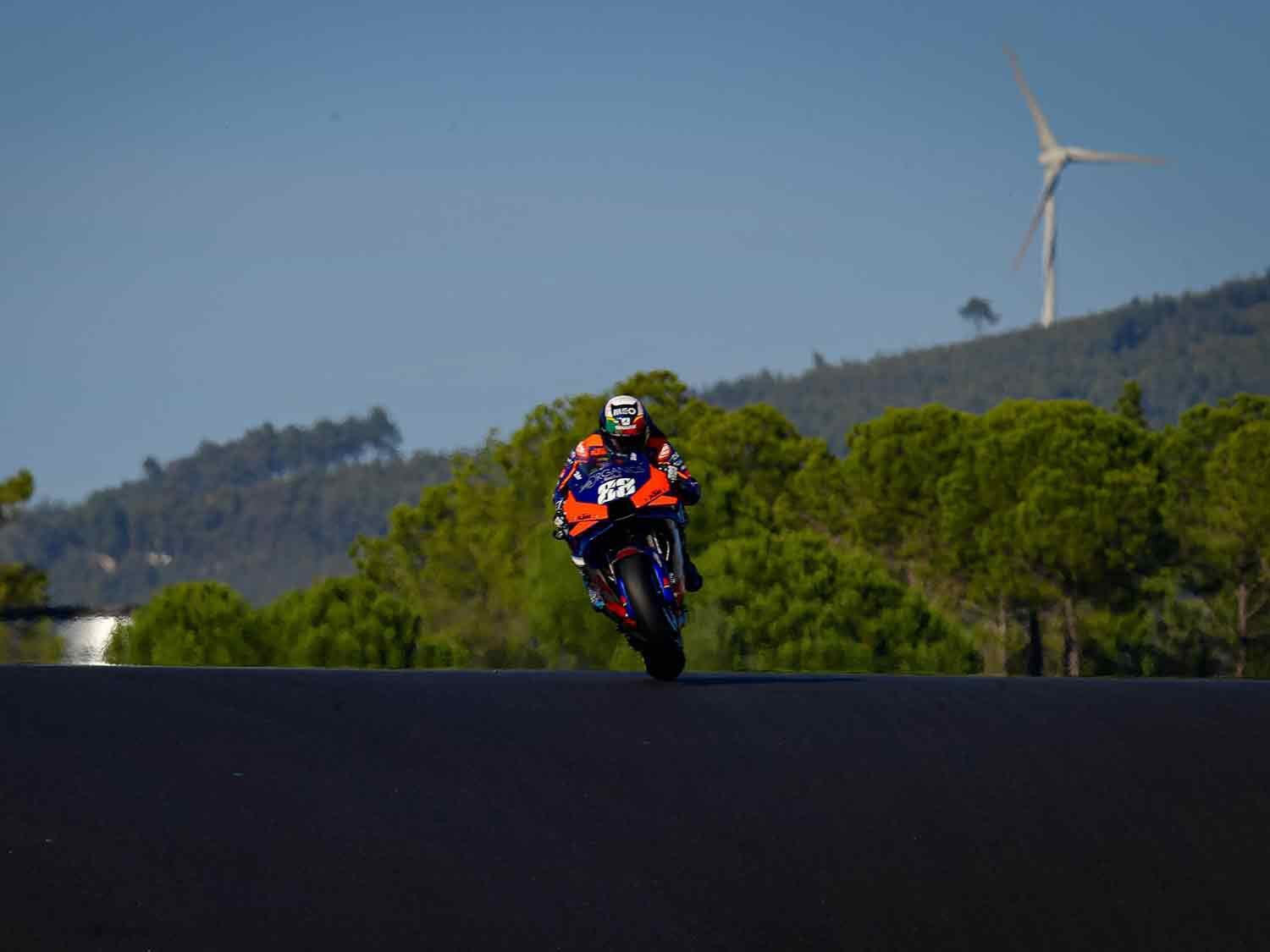
What will be in 2021? Will teams like Tech3 continue to see success when Marc Márquez returns to competition? (MotoGP/) If what MotoGP has to sell is suspense, this year brought a bumper crop, as up-and-coming riders up-and-arrived, gaining in confidence and experience. Will they wilt in 2021 as Marc Márquez returns full strength to shade them out? No one rider stands out, for the system now in place has provided all with the same excellent schooling of national series, then Moto3 and Moto2 to prepare the top performers for MotoGP. Meanwhile a series of schemes to put competitive bikes on the start grid has succeeded in placing each arriving graduate on a fully engineered bike, designed from the start as a factory MotoGP machine. This has brought machine and rider parity comparable to that of Moto2 while preserving the proven appeal of many brands in contention.
Prospects for a return of this suspense in 2021 look good.
-
Hello wolf125,
Welcome to The Motorbike forum. Please feel free to browse around and get to know the others. If you have any questions please don't hesitate to ask.
Why not tell us a bit about yourself too.
-
Hello Andyrew,
Welcome to The Motorbike forum. Please feel free to browse around and get to know the others. If you have any questions please don't hesitate to ask.
-
Hello Basshead,
Welcome to The Motorbike forum. Please feel free to browse around and get to know the others. If you have any questions please don't hesitate to ask.
-
Hello onedreamride,
Welcome to The Motorbike forum. Please feel free to browse around and get to know the others. If you have any questions please don't hesitate to ask.
-
-
Hello Dossie,
Welcome to The Motorbike forum. Please feel free to browse around and get to know the others. If you have any questions please don't hesitate to ask.
-
Hello SteveO,
Welcome to The Motorbike forum. Please feel free to browse around and get to know the others. If you have any questions please don't hesitate to ask.
-
Hello Raijin,
Welcome to The Motorbike forum. Please feel free to browse around and get to know the others. If you have any questions please don't hesitate to ask.
-
Hello Jim,
Welcome to The Motorbike forum. Please feel free to browse around and get to know the others. If you have any questions please don't hesitate to ask.
-
Hello Emily,
Welcome to The Motorbike forum. Please feel free to browse around and get to know the others. If you have any questions please don't hesitate to ask.
-
Hello Dai Loughor,
Welcome to The Motorbike forum. Please feel free to browse around and get to know the others. If you have any questions please don't hesitate to ask.
-
-
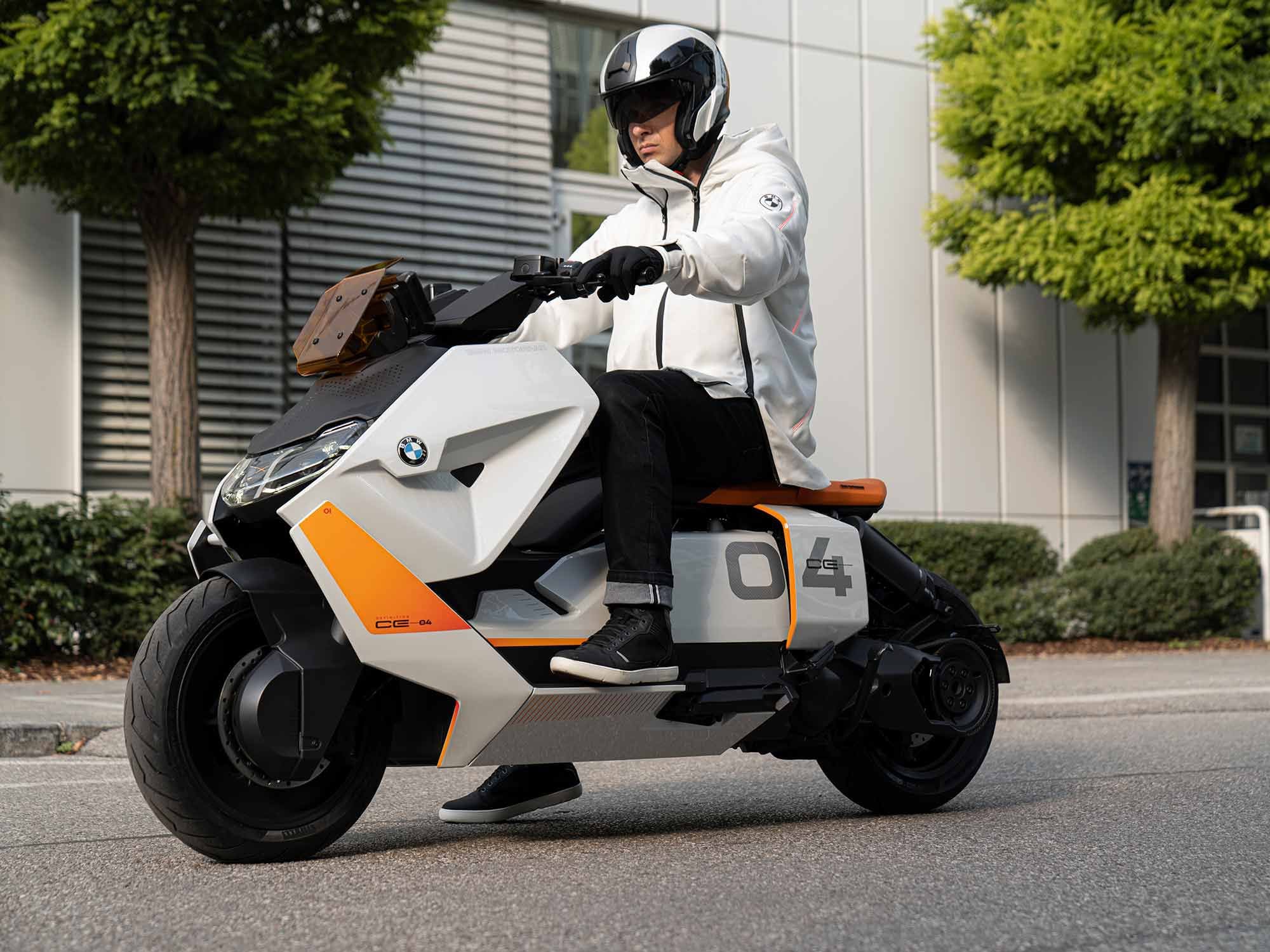
BMW recently showed off the Definition CE 04 electric scooter. Where are the motorcycles? (BMW Motorrad/) BMW has recently treated the press to a non-contact digital look at its far-reaching plans for future automobile electrification, safety, connectedness, and autonomy, but save for the new Definition CE 04 electric scooter, said to be close to production, the presentation passed over two-wheeled plans.
RELATED: BMW Radical New Electric Scooter
This makes sense because: 1) automakers must scramble hard for places on the escalator to the fast-evolving auto future, yet 2) it’s hard to envision BMW’s established motorcycle line of long-distance tourers and adventure bikes being successfully electrified at this point. As a learning experiment, at the end of 2016 the company gave the urban transportation field a whirl by announcing the BMW C Evolution electric scooter. Reviewers gave it decent marks as a test of concept, but at its 15,000 euro price (that’s US $17,850 today), 606-pound weight, and limited on-board storage (batteries take up a lot of volume) it was not for nimbly beating traffic while carrying out impulse shopping raids.
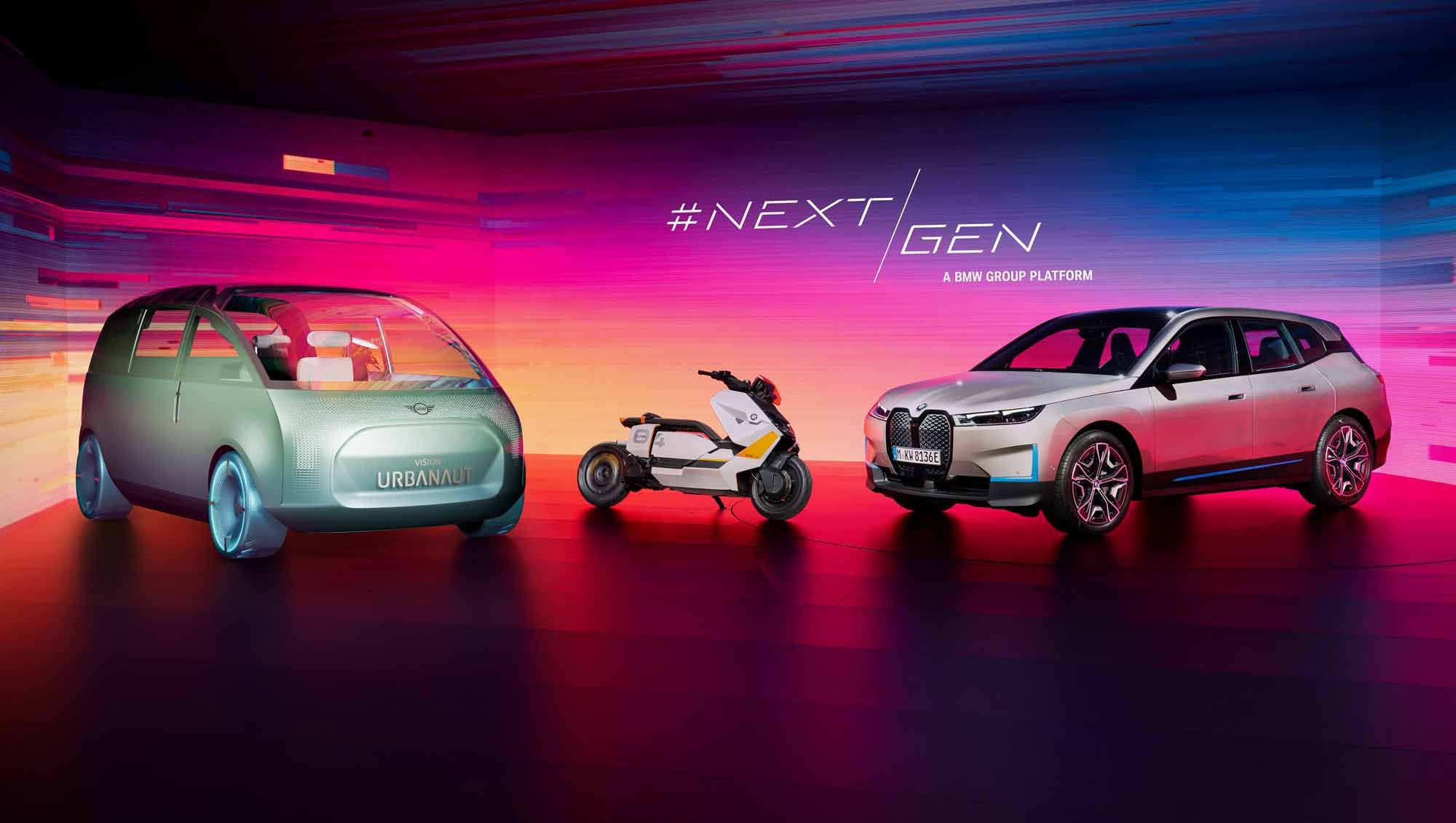
The Definition CE 04 was the only two-wheeled BMW in the #NEXTgen 2020 presentation. (BMW Motorrad/) Based upon experience with C Evolution, the correct properties of an urban transport module became clearer. For a likely daily commute of 12 kilometers (7.5 miles) and on the needs for ease of handling (the classic Vespa, as seen in the 1953 movie Roman Holiday, weighed 253 pounds!) and the secure carriage of parcels, the vehicle was redesigned. The engineers reduced battery weight, putting it where you least feel it (under the floor pan) with performance realistic for the application. Helmet-size underseat storage was added.
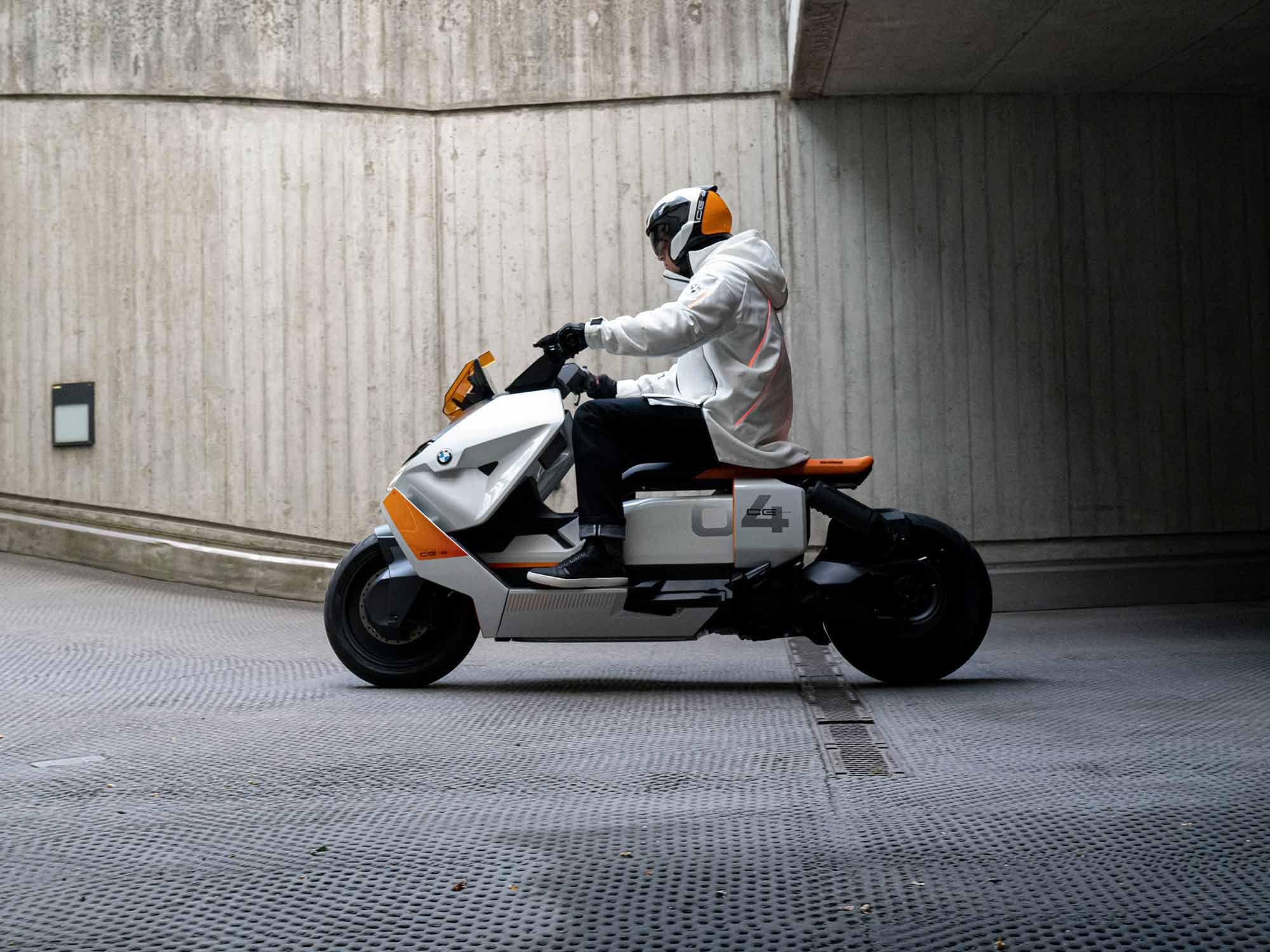
Reduced battery weight placed lower in the chassis than the C Evolution scooter is said to make the Definition CE 04 more suitable for the rigors of urban use. (BMW Motorrad/) No real specifications or likely price were released, but at the rear, a glimpse of mechanism confirms a single-sided swingarm, cog belt drive, and single-shock suspension. A 10-inch data screen interfaces with your phone to keep you connected and updated. Finally, the vehicle delivers the radical style you see here, in line with Europe’s current love affair with origami. Don the matching riding gear, singling you out as part of the solution, not part of the problem. The jacket illuminates to signal braking or turning, while wirelessly charging your phone in its dedicated pocket. Savor an abstract, unknowable, but infinitely cool electric future.
It’s not in showrooms yet but BMW tells us that something close is coming very soon, likely within a year.
-
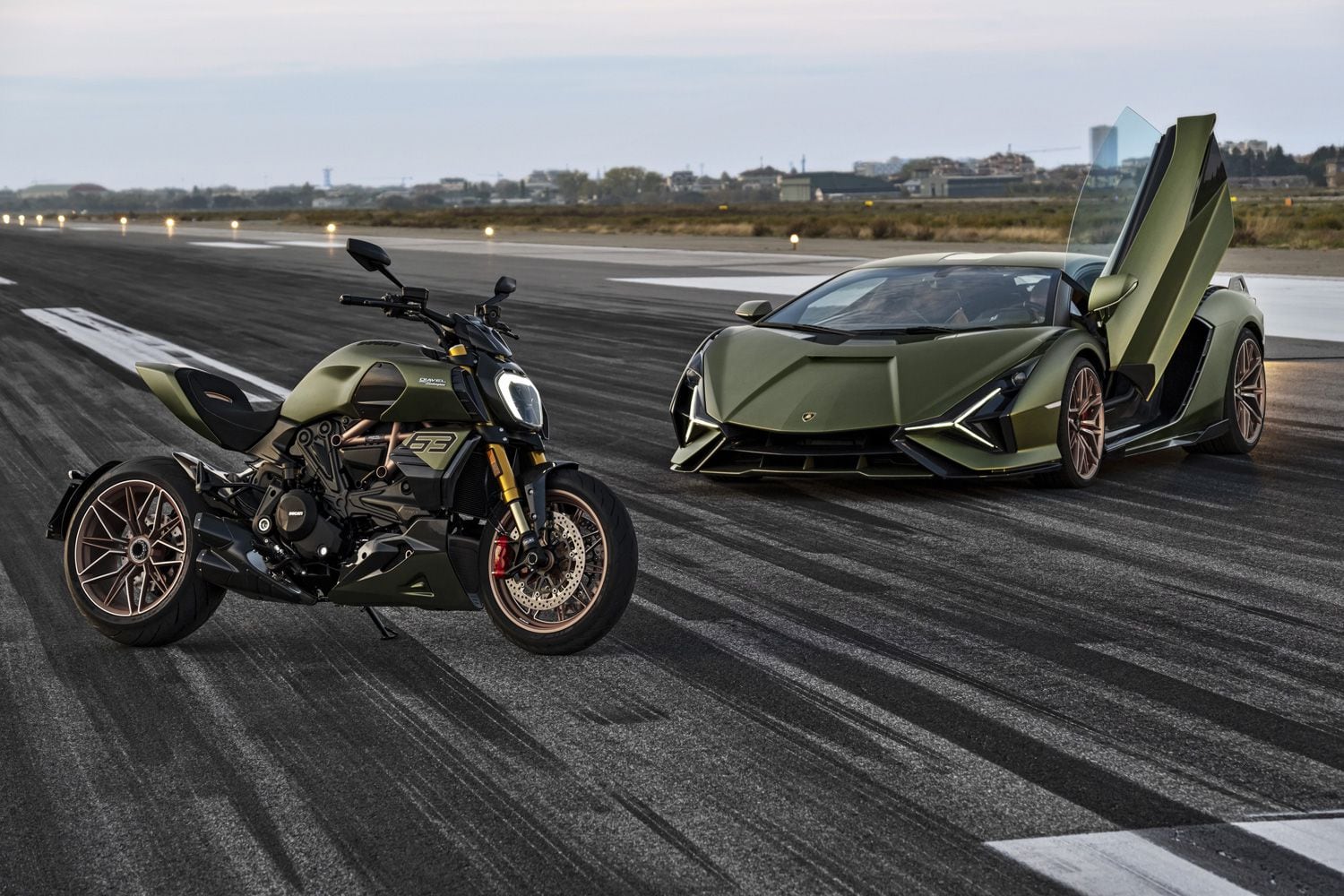
The 2021 Ducati Diavel 1260 Lamborghini is inspired by the Lamborghini Sián FKP 37 supercar. (Ducati/) If you think hard, Ducati’s power cruiser, the Diavel, remains a big question mark 10 years on from its introduction. Then-CEO Gabriele Del Torchio was negotiating the acquisition of Ducati by Audi and he really wanted to polish all the silverware in order to trade the Borgo Panigale motorcycle brand at the highest possible price. Ducati was VW-Audi boss Ferdinand Piëch’s special gift for his 75th birthday. He wanted Ducati badly because he had been a long believer of Dr. Taglioni’s desmodromic valve actuation. Del Torchio wanted to add new models into Ducati’s Pandora box, and so he forced his technical team to give life to something absolutely outstanding that would add more value to the marque.
Enter the Panigale 1200 and the Diavel. The Panigale 1200, powered by the most advanced and fascinating V-twin in history, built in the Ducati tradition of supreme superbikes. Diavel was almost the opposite, a model that was treading on unknown turf. In the Ducati way, the Diavel was loaded with power never seen before on a cruiser and was styled to the extreme. Sure, it proved the most powerful, the fastest cruiser in production, and it did it in good composure thanks to a sportbike-derived chassis. But how the Diavel was perceived by cruisers communities around the world and how well it fared on the market we will never know for sure. “Mixed” is the best way to interpret the market’s reaction.
To me it seems that it has lived on a sequence of well-publicized numbered “special editions” that helped keep the name alive. The recent XDiavel Dark and Black Star are part of this marketing policy, and now comes the ultimate variation: the Ducati Diavel 1260 Lamborghini.
Ducati and Lamborghini both are under the umbrella of the Audi Group and their factories are set few miles apart in that very special section of Italy known as Motor Valley where in less than 70 miles you go from Dallara in Parma, to Ferrari and Maserati in Modena, to Ducati in Bologna, plus a myriad of fantastic little shops where grinders and lathes and CNC machinery turn out mechanical components that are real jewels.
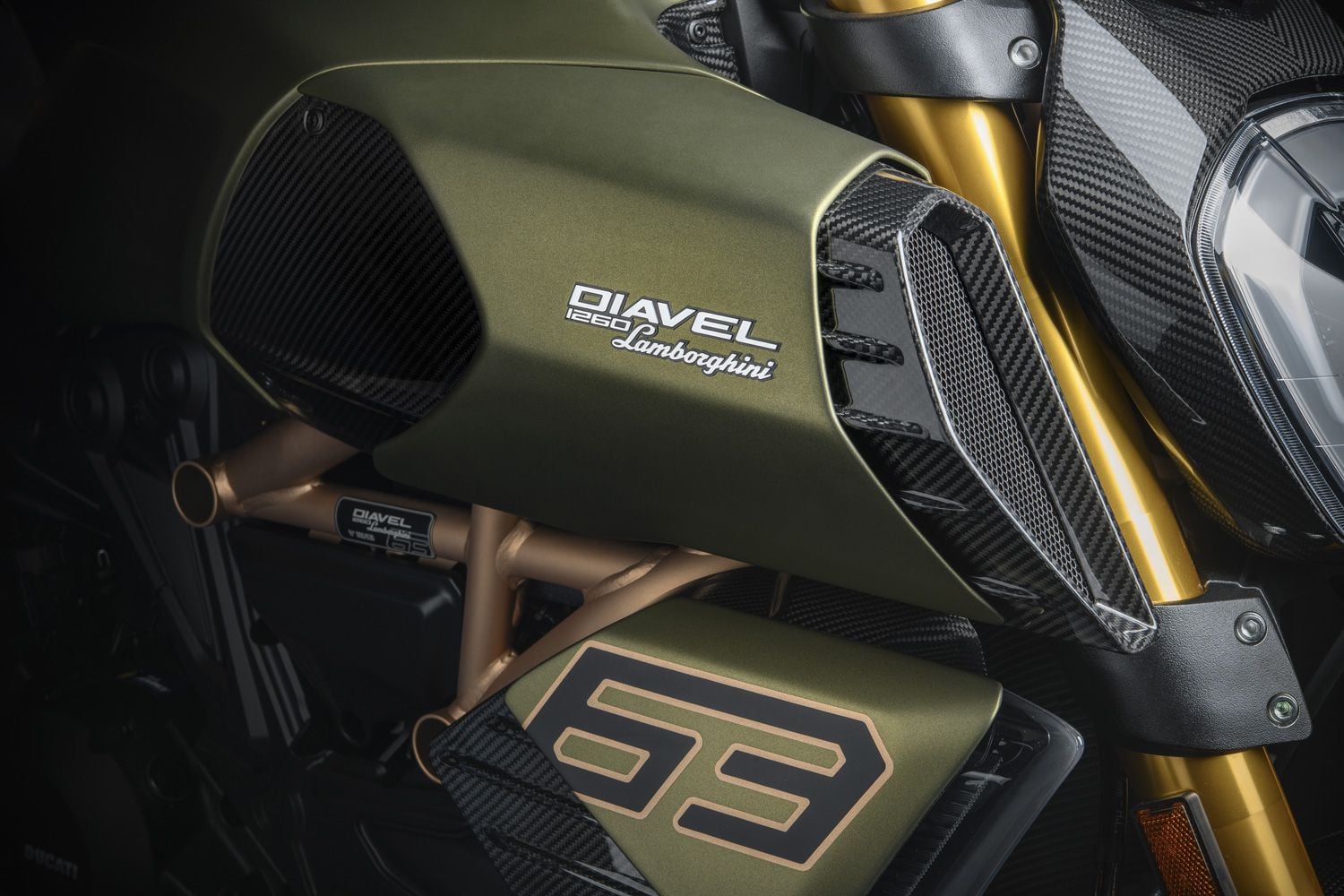
Both Ducati and Lamborghini are part of the Audi Group; now the two have worked together to create a special-edition Diavel 1260. No pricing is set as of yet, but expect it to be expensive and sell out quickly. (Ducati/) Ducati and Lamborghini joined styling department forces to create a very special edition of the Diavel, vastly inspired by the unique Lamborghini Sián FKP 37, the most powerful Lamborghini ever designed that will be manufactured in a numbered batch of 63 units, to celebrate the year Lamborghini was founded—1963. Its unique, hybrid power unit delivers a total of 819 hp.
First, the Diavel 1260 Lamborghini shares the same very special tone of metallic green known as Gea Green. New panels and air intakes have been added to complete the design of the Diavel and make it more muscular and car inspired. Every detail shows supreme quality execution. The relationship with the Sián FKP 37 is strongly underlined by the forged aluminum wheels featuring the same spoke design and the same gold coloring, shared also by the classic steel tubing trellis frame. With the help of extensive use of carbon fiber body parts, plus exhaust system tips, the Diavel 1260 Lamborghini keeps its dry weight at a claimed 485 pounds. Only a touch of red comes from the Brembo front brake Monoblock calipers.
As its identification announces, the Diavel 1260 Lamborghini is powered by the very special 1,262cc variation of the Testastretta Ducati 90-degree V-twin featuring the unique DVT (aka Desmo Variable Timing) to deliver a solid 162 hp at 9,500 rpm and a generous 95 pound-feet of peak torque at 7,500 rpm in this new Euro 5 homologated execution.
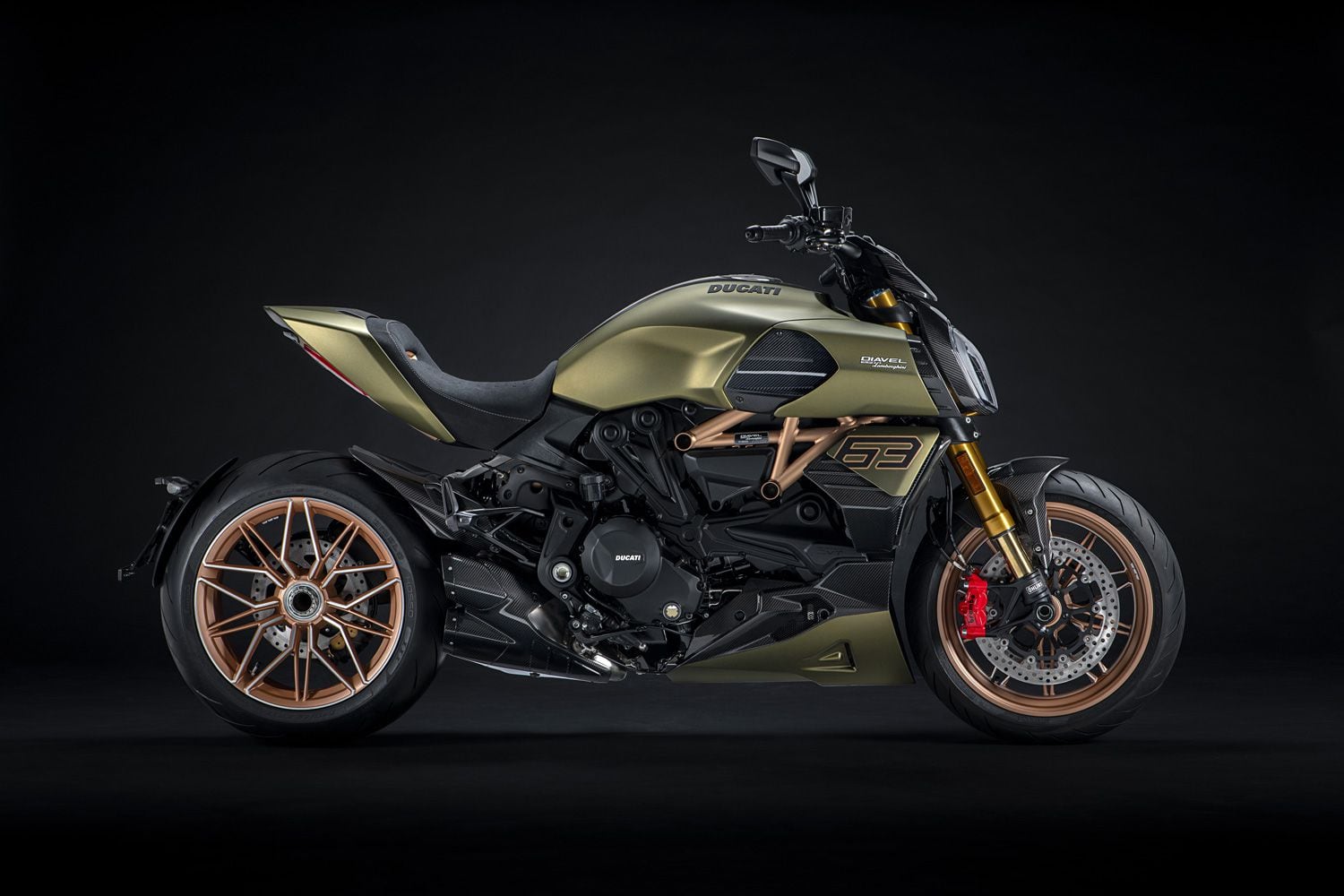
The 2021 Ducati Diavel 1260 Lamborghini is available in only one color: Gea Green with Electrum Gold frame and wheels. (Ducati/) Suspension is by Öhlins: A 48 millimeter fork and gas-charged rear monoshock, both fully adjustable. The electronics suite is top class, based on a Bosch six-axis inertial platform 6D IMU that manages all major riding and safety assist functions: ABS cornering control, traction and wheelie control, and power launch control. The TFT display of the instrumentation manages the Ducati Multimedia connectivity system.
To underline the association with the Lamborghini supercar, Diavel 1260 Lamborghini shows a big number “63” on the radiator side panels, but in this case the numbered units will be 630. Price to be announced at a later date.
-
Hello jackzi,
Welcome to The Motorbike forum. Please feel free to browse around and get to know the others. If you have any questions please don't hesitate to ask.
-
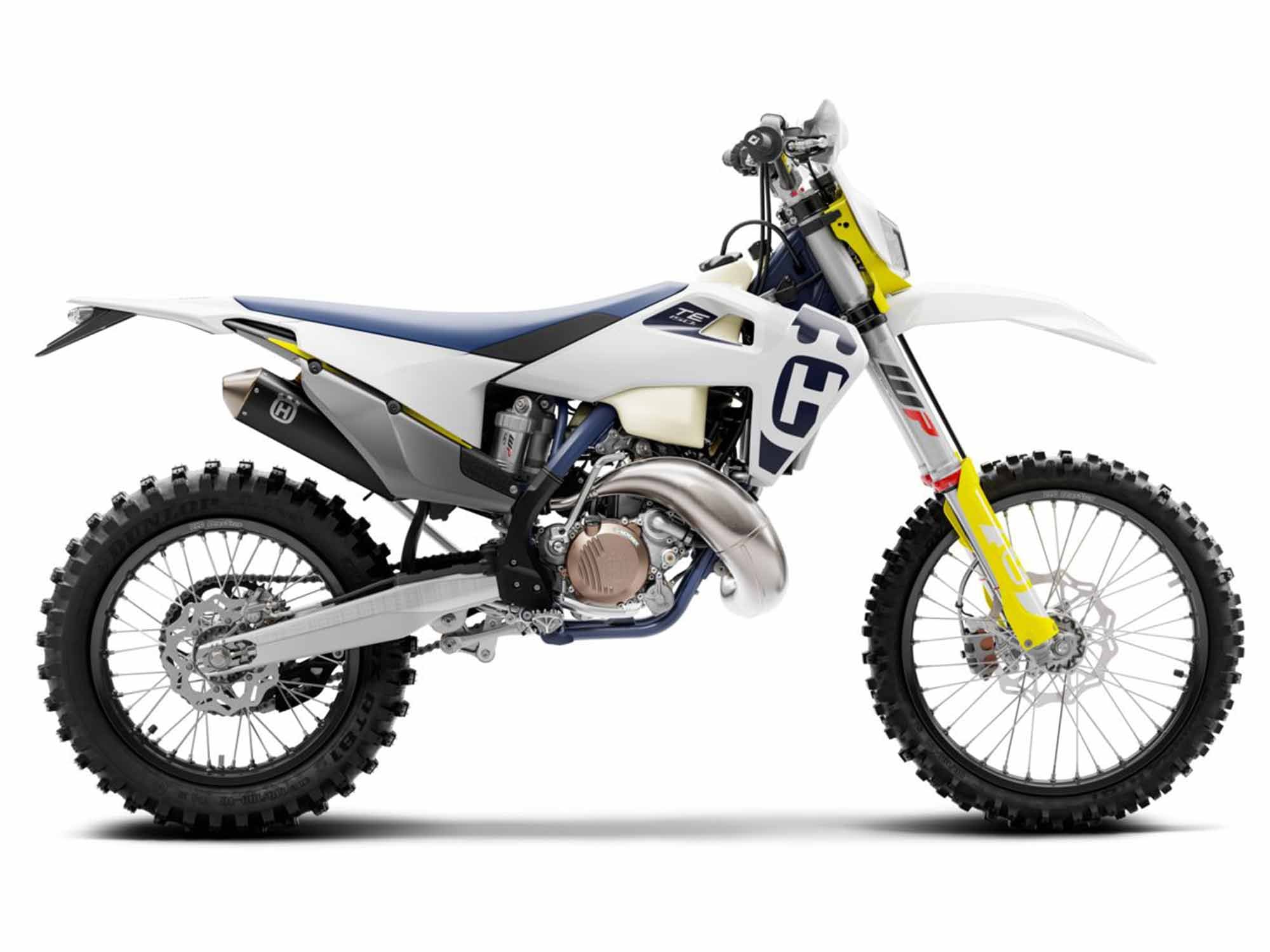
2020 Husqvarna TE 150i (Husqvarna/) The Husqvarna TE 150i is a two-stroke dirt bike designed for the trails and at 219 pounds (dry, claimed weight) is the lightest model in the range, Husky says. Its light weight and nimbleness are useful for slaloming in between trees while the WP Xplor and WP Xact front and rear suspension deliver consistent damping over terrain thanks to refining updates made for the 2020 MY. Other features include Magura brakes, toggleable mapping options, an electric starter, and, the biggest change for 2020, electronic fuel injection. This is one trick enduro bike.
2020 Husqvarna TE 150i Reviews, Comparisons, And Competition
When Dirt Rider took the 2019 TE 150 out on the trails in New York, the test rider reported that the TE cut through trails and obstacles with ease and that its “impressive power-to-weight ratio allow a rider to be aggressive with an easily managed powerband.”
Competition for this fuel-injected two-stroke includes the TM EN 144 Fi and KTM 150 XC-W TPI. For those not as concerned with displacement as they are with having a unique brand of off-road bike, you can look toward the Sherco 125 SE Racing model or Beta 125 RR as the TE’s other competition.
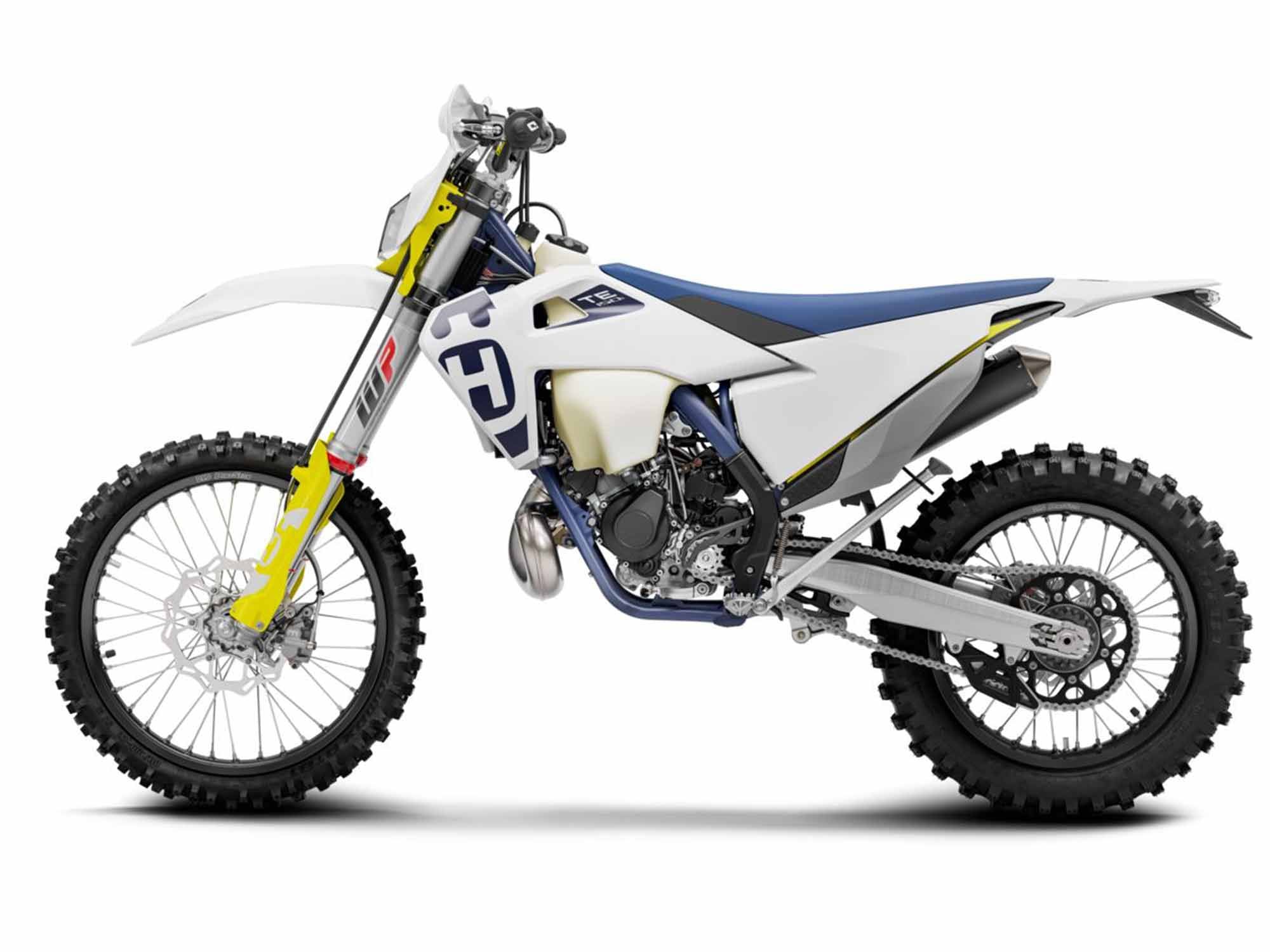
2020 Husqvarna TE 150i (Husqvarna/) Husqvarna TE 150i Updates For 2020
The 2020 TE 150i (and the whole Husqvarna Enduro line) have undergone major updates to the chassis, suspension, and bodywork. More specifically, this includes a more rigid frame (Husky specifies for more longitudinal and torsional rigidity), a claimed 250-gram-lighter carbon fiber subframe, new aluminum cylinder head mountings, and updated suspension that offers “simple adjustment, more consistent damping, and better resistance to bottoming,” Husky says. The TE 150i also now shares the same two-stroke electronic fuel-injection tech as the TE 250i and TE 300i. Across the MY20 range, the models also see a claimed 0.4-inch drop in seat height. New bodywork and graphics are just the cherry on top.
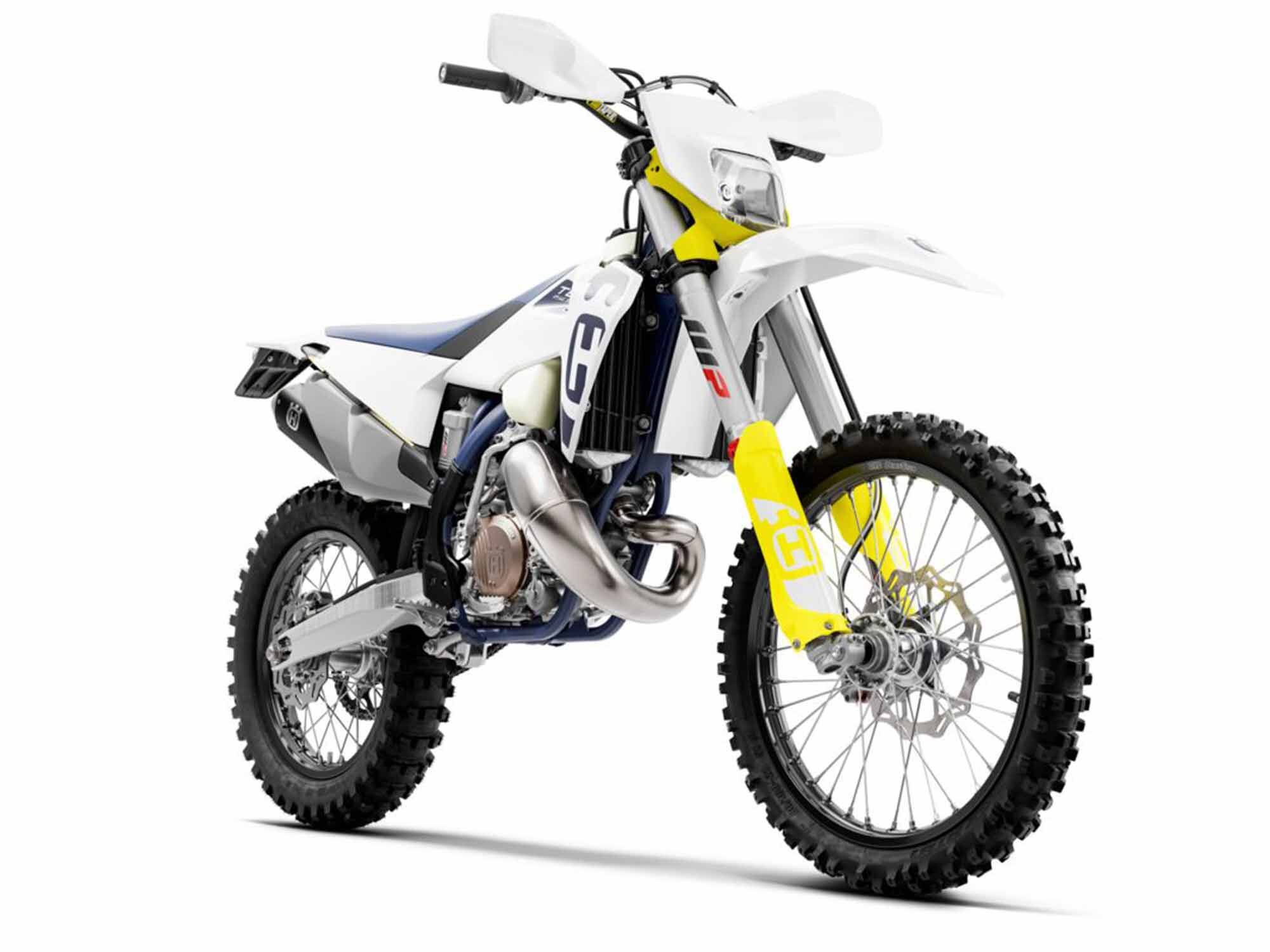
2020 Husqvarna TE 150i (Husqvarna/) 2020 Husqvarna TE 150i Claimed Specifications
Price: $8,899 Engine: Liquid-cooled single-cylinder two-stroke Liquid-cooled SOHC single-cylinder Displacement: 144cc Bore x Stroke: 58.0 x 54.5mm Horsepower: N/A Torque: N/A Transmission: 6-speed Final Drive: Chain Seat Height: 37.4 in. Rake: 26.5° Trail: N/A N/A Front Suspension: 48mm inverted fork, fully adjustable; 11.8-in. travel Rear Suspension: Fully adjustable; 11.8-in. travel Front Tire: 90/90R-21 Rear Tire: 140/80R-18 Wheelbase: 58.5 in. Fuel Capacity: 2.3 gal. Dry Weight: 219 lb. -
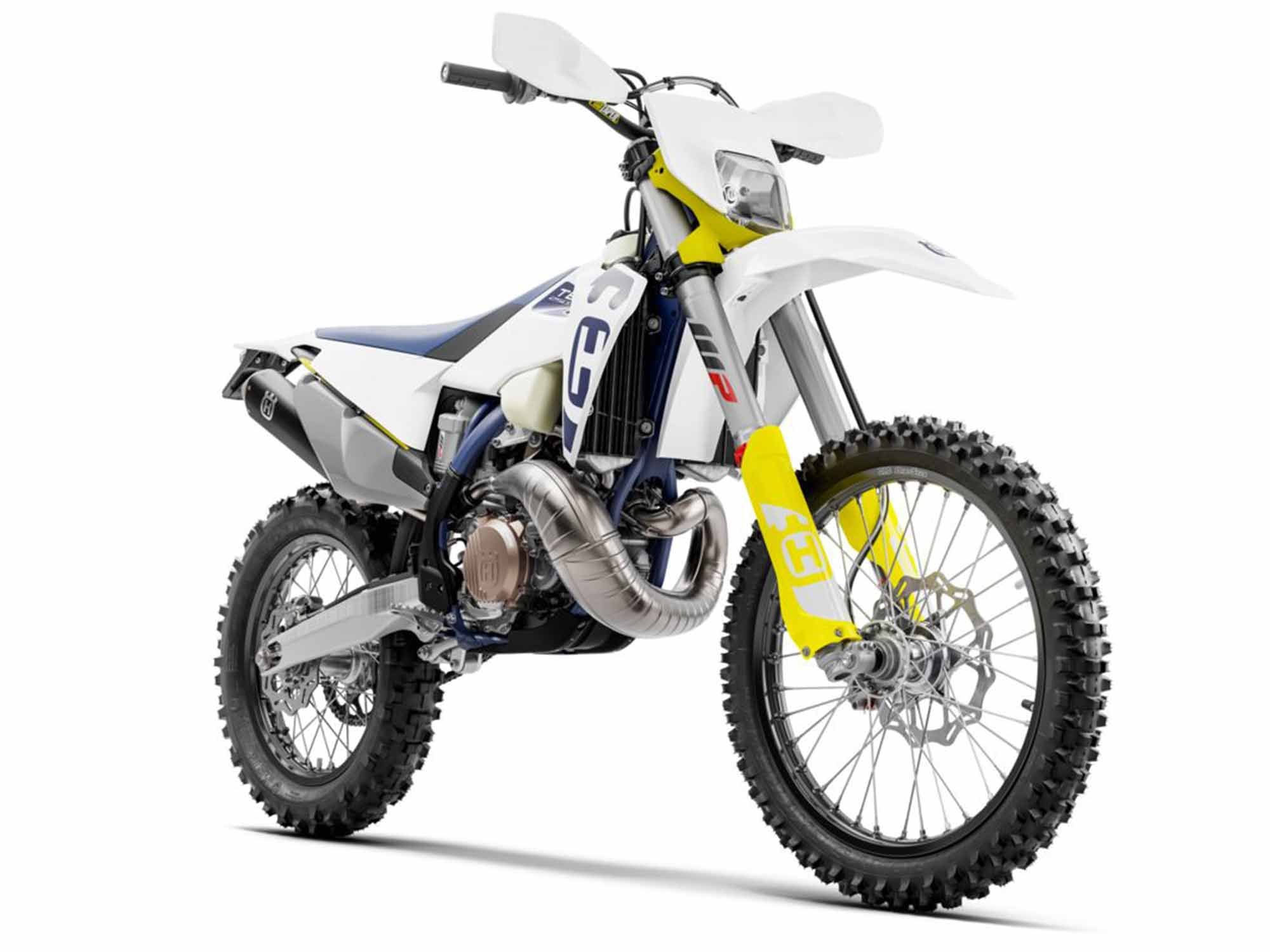
2020 Husqvarna TE 250i (Husqvarna/) The Husqvarna TE 250i is the brand’s two-stroke enduro model that features electronic fuel injection (indicated by the “i” in the model name). Although two-strokes have been increasingly replaced by four-stroke models, Husqvarna still sees value in enhancing the two-strokes with the new-age tech—no more premixing fuel or making jetting changes. Getting into the internals of the machine, Husqvarna says, “With a heavier ignition rotor, the crankshaft produces more inertia than its motocross counterpart [TC 250], which improves control in the lower rpm,” a valuable feature for when traversing the single-track where slow riding technique is key.
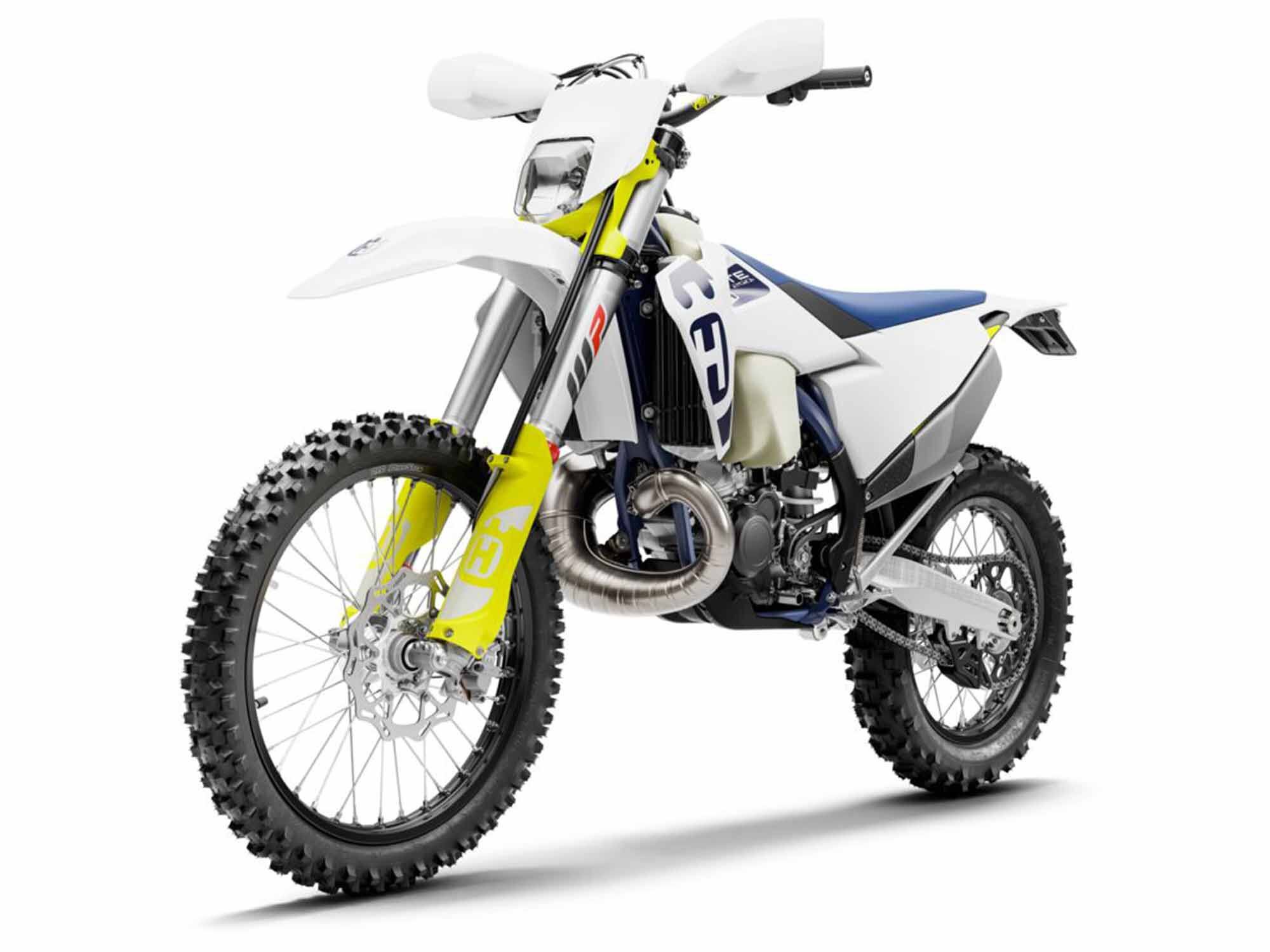
2020 Husqvarna TE 250i (Husqvarna/) 2020 Husqvarna TE 250i Reviews, Comparisons, And Competition
When the fuel-injected model was introduced in 2018, test rider Andrew Oldar found the 250 was “noticeably more flickable” than its 300 counterpart, which is good news considering the 250 was the one to make it stateside that year. Oldar wrote that the 250i engine performed well at super-low rpm in first gear but even better in second gear on more technical single-track trails.
Spinning the rear wheel on our in-house dyno, the 2019 Husqvarna TE 250i’s fuel-injected engine produced 40.74 hp at 8,230 rpm and 27.49 pound-feet of torque at 7,580 rpm.
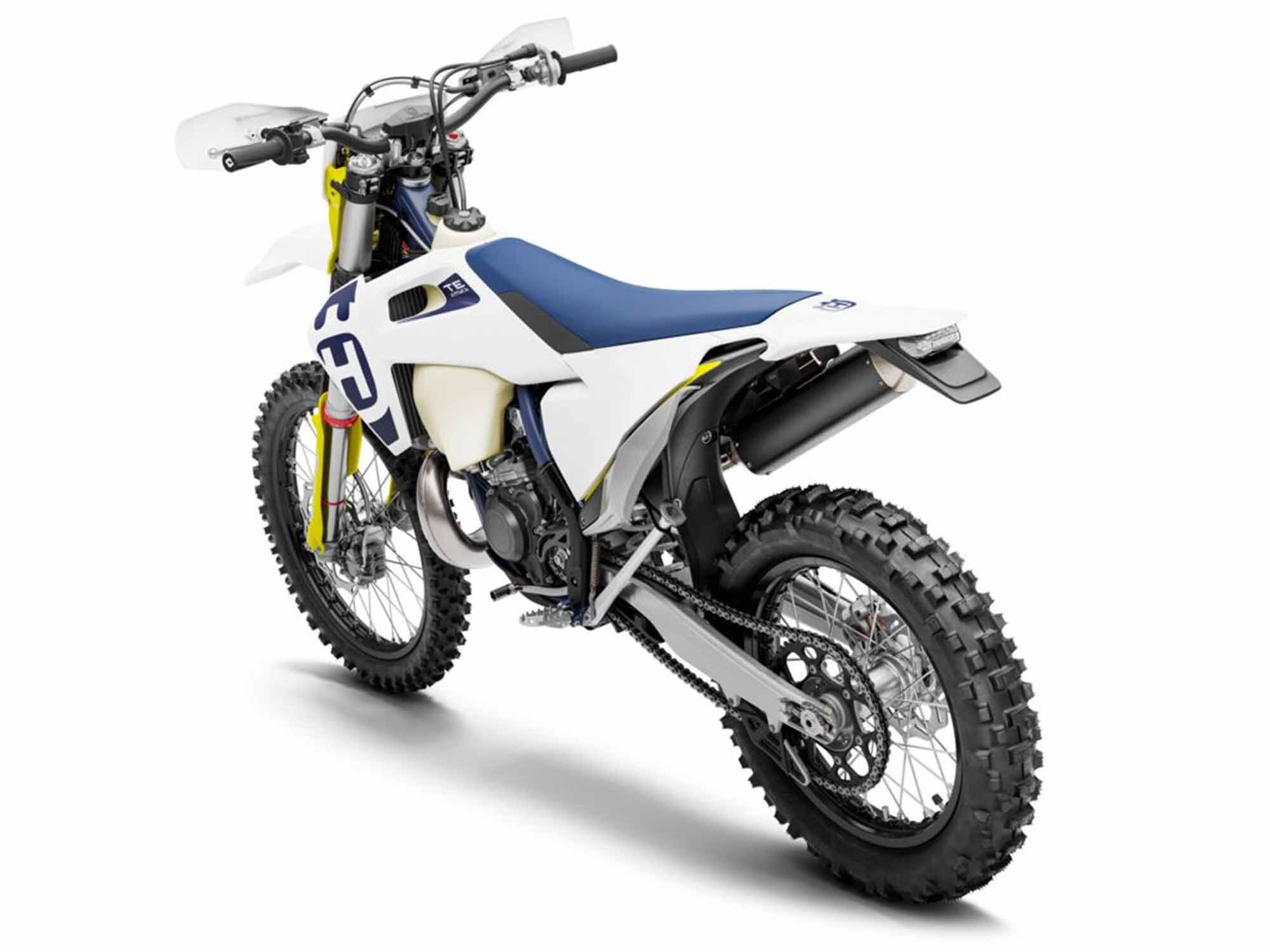
2020 Husqvarna TE 250i (Husqvarna/) Husqvarna TE 250i Updates For 2020
For 2020, Husqvarna updated the cylinder for better performance, added a new water pump casing to improve cooling by optimizing the flow of coolant, lightened the subframe by 0.6 pound, updated suspension, swapped out a new exhaust, and wrapped new bodywork around a new frame.
2020 Husqvarna TE 250i Claimed Specifications
Price: $9,899 Engine: Liquid-cooled single-cylinder two-stroke Displacement: 249cc Bore x Stroke: 66.4 x 72.0mm Horsepower: N/A Torque: N/A Transmission: 6-speed Final Drive: Chain Seat Height: 37.4 in. Rake: 26.5° Trail: N/A Front Suspension: 48mm inverted fork, fully adjustable; 11.8-in. travel Rear Suspension: Fully adjustable; 11.8-in. travel Front Tire: 90/90-21 Rear Tire: 140/80-18 Wheelbase: 58.5 in. Fuel Capacity: 2.2 gal. Wet Weight: 232 lb. -
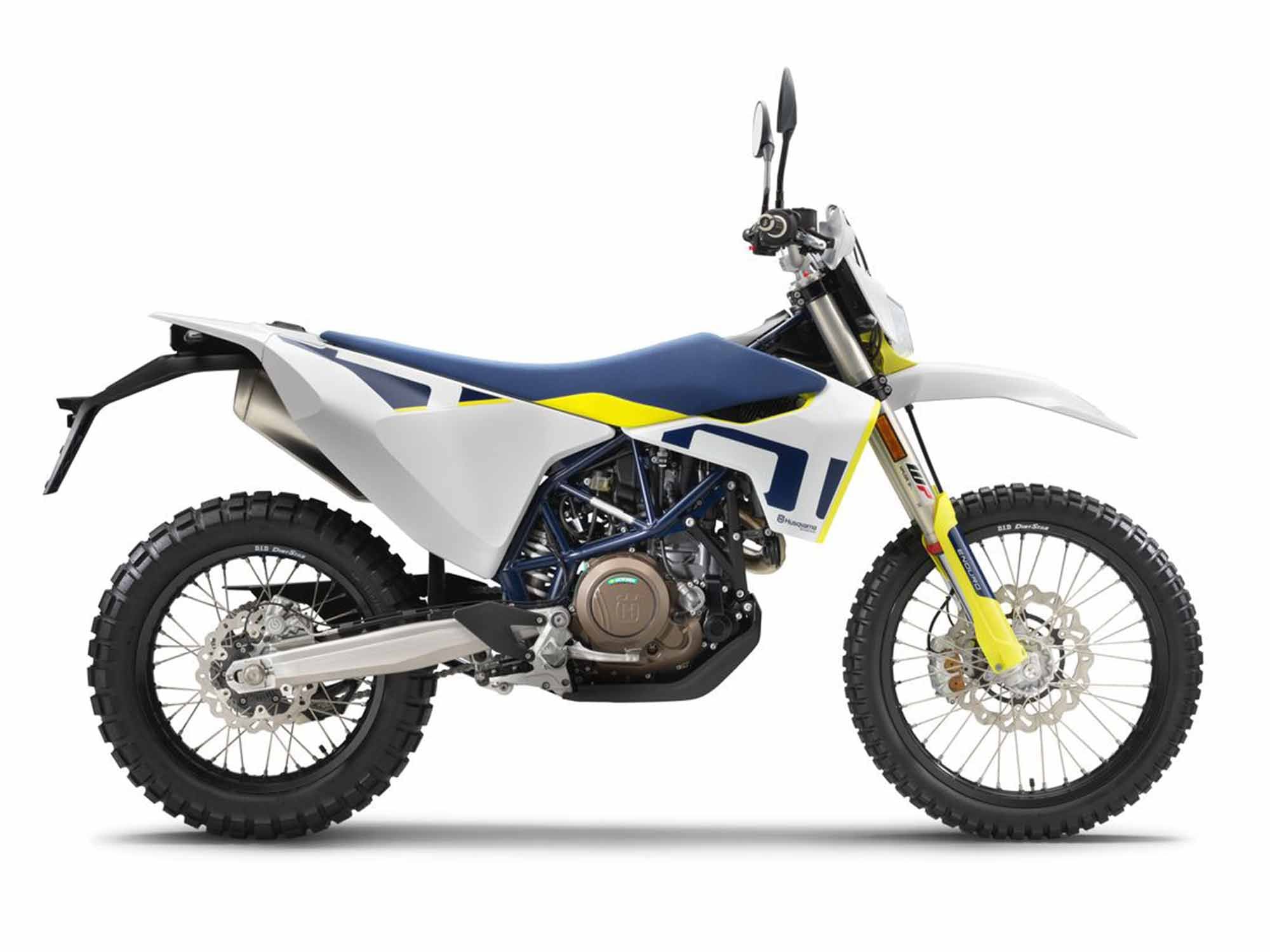
2020 Husqvarna 701 Enduro (Husqvarna/) Husqvarna’s on-road 701 Supermoto meets its dual sport match in the 701 Enduro. These models share more than the $11,999 MSRP, 693cc single-cylinder engine, slim chrome-moly steel trellis frame and fuel-tank-integrated rear subframe. What sets the 701 Enduro apart is how it meets the challenges of the road and dirt with equal capability thanks to WP Xplor suspension and 21- and 18-inch wheels. It also shares electronic rider aids like switchable ride modes, cornering ABS, traction control, and up and down quickshifter with the 701 Supermoto.
2020 Husqvarna 701 Enduro Reviews, Comparisons, And Competition
In our 2016 ride review our test rider said: “Splashing down wide, rain-soaked trails, the Enduro behaved quite well for a 320-pound dirt bike—this despite the shallow depth of the knobs, which preferred to spin rather than grip in such conditions. Keeping the ABS switched to the front-only setting, I was able to slide the rear to get the bike pivoted and pointed out of turns—a useful feature when riding aggressively off-road.”
Competition includes the KTM 690 Enduro R, Honda XR650L, and Suzuki DR650S.
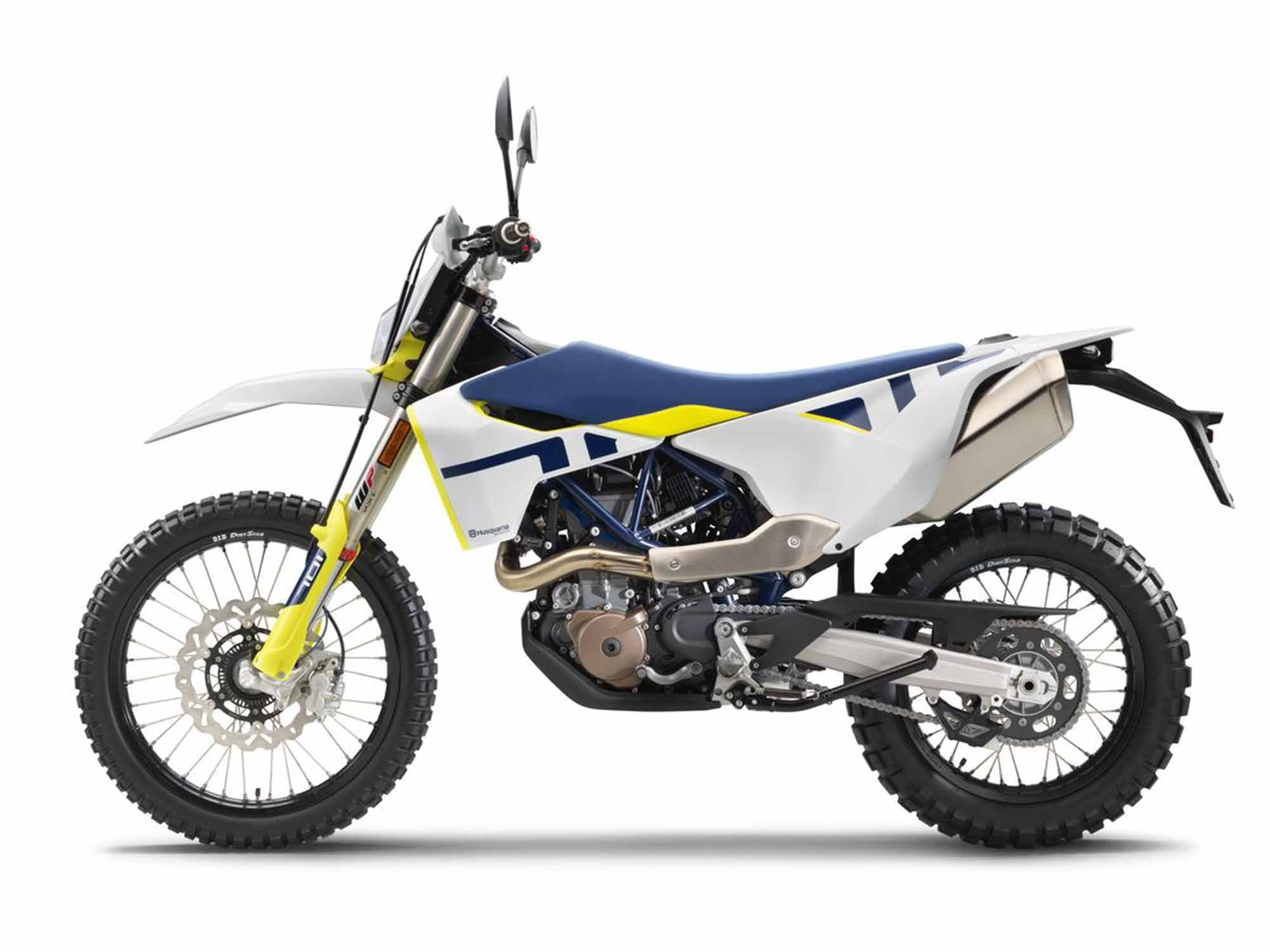
2020 Husqvarna 701 Enduro (Husqvarna/) Husqvarna 701 Enduro Updates For 2020
In addition to the electronic suite and new graphics for the 2020 Enduro, there is also a new addition to the 701 lineup: the 701 Enduro LR (long range). Husky says this shares the same electronics as the 701 Enduro, but offers even more touring capabilities with the addition of the larger 12-liter (3.2 gallons) auxiliary fuel tank to up total fuel capacity to 25 liters (6.6 gallons).
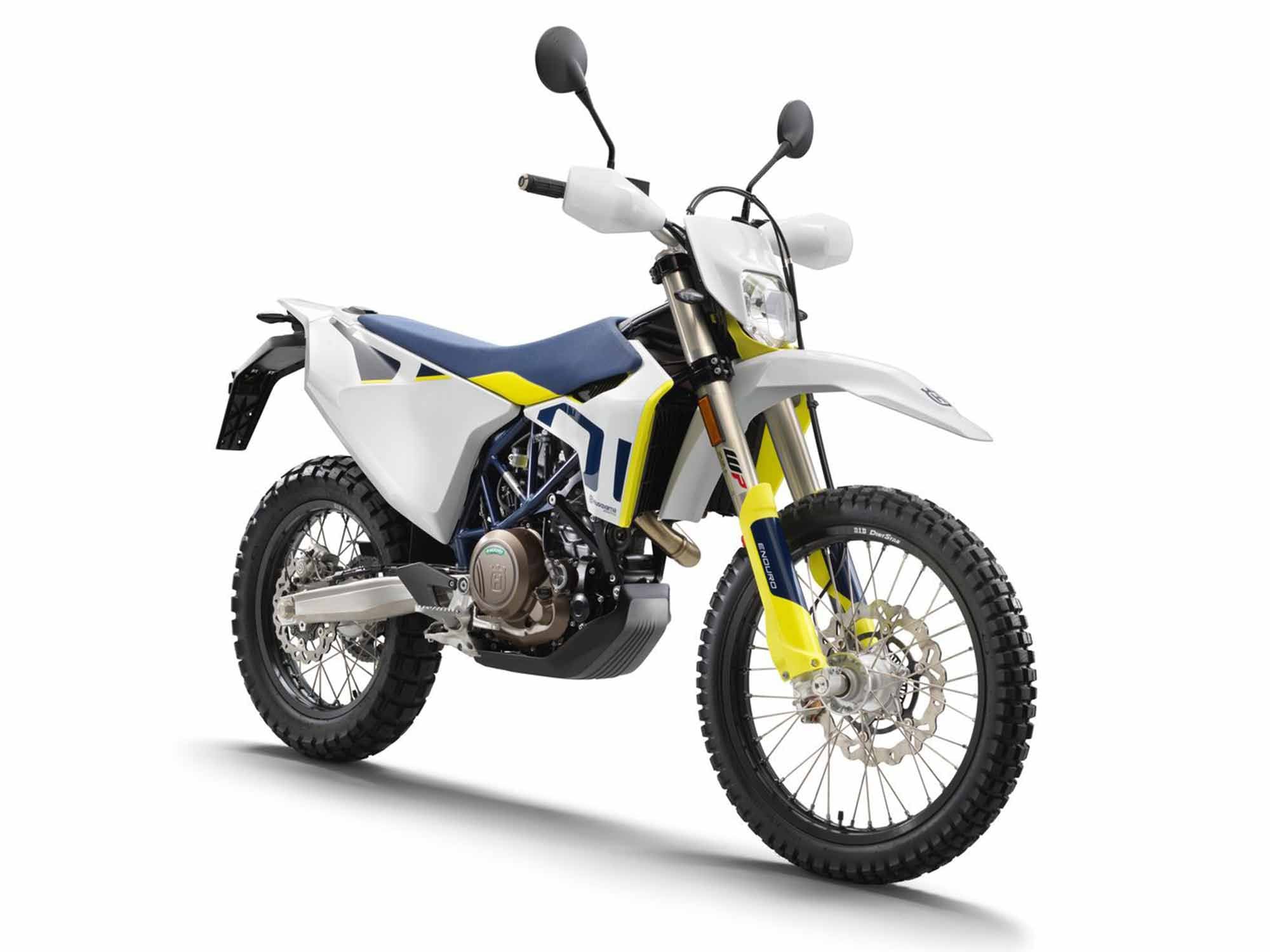
2020 Husqvarna 701 Enduro (Husqvarna/) 2020 Husqvarna 701 Enduro Claimed Specifications
Price: $11,999 Engine: Liquid-cooled SOHC single-cylinder Displacement: 693cc Bore x Stroke: 105.0 x 80.0mm Horsepower: 74.0 hp @ 8,000 rpm Torque: 54.2 lb.-ft. @ 6,500 rpm Transmission: 6-speed Final Drive: Chain Seat Height: 36.2 in. Rake: N/A Trail: N/A Front Suspension: 48mm inverted fork, compression and rebound adjustable; 9.8-in. travel Rear Suspension: Fully adjustable; 9.8-in. travel Front Tire: 90/90R-21 Rear Tire: 140/80-18 Wheelbase: 59.1 in. Fuel Capacity: 3.4 gal. Dry Weight: 322 lb.

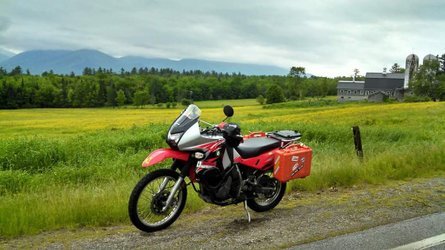
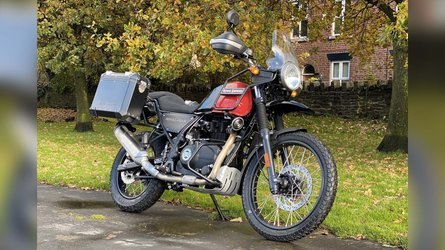
Is Suzuki Working on a New V-Strom 650?
in Motorbike news
Posted
Suzuki’s ongoing development of a new parallel-twin-powered model seems to be accelerating with yet more patents emerging in Japan that suggest multiple bikes are being conceived concurrently around the same new engine.
While the rest of Japan’s Big Four manufacturers have already launched several new or updated 2021 models this year, Suzuki has had little to show other than new paint schemes, and the last couple of years have told a similar story. The V-Strom 1050 and Katana are the most significant new models from the firm in the last 24 months, and both are heavily based on existing bikes. The last clean-sheet new model we saw from Suzuki in Western markets was the GSX-R1000 back in 2017.
But all-new bikes take time to develop and Suzuki’s R&D department hasn’t been slacking, instead putting a huge amount of work into the development of its new parallel twin.
First seen as the “XE7” turbocharged engine, which was given a low-key reveal at the 2015 Tokyo Motor Show, the new powerplant has since appeared in a host of patents for a wide variety of models. Believed to displace around 700cc, the DOHC motor’s initial development was in boosted form and probably good for around 150 hp. It also showed up in various designs based on the earlier Recursion concept from 2013, which had featured a smaller, 588cc, SOHC twin.
More recently we’ve seen that Suzuki is developing a normally aspirated version of the new engine, clearly destined as a replacement for the SV650. And now another patent filed in Japan hints at an adventure style model to replace the V-Strom 650. The picture is starting to emerge of an entire range of Suzukis, across a spectrum of different styles and performance levels, built around variations of the same engine.
The latest designs show the now-familiar parallel twin, but where the previous patents illustrated a street-oriented model in the mold of the SV650, with a very low-profile oil pan fitted to allow the engine to be installed as low as possible in the chassis, the latest designs reveal a much deeper oil pan and taller seat along with a completely different frame layout and an unusual airbox design.
Previously we saw the airbox above the engine, with curved intakes leading to near-vertical throttle bodies to keep it compact. On the new design, all that is gone, replaced with a set of horizontal throttle bodies leading to an airbox that’s sited under the seat, sculpted to fit around the upper end of the rear shock.
It’s a layout that takes advantage of the tall seat of the adventure-style design, and one that leaves the area above the engine free to fit a larger fuel tank. The airbox itself is sealed where it’s exposed to the rear wheel, with an intake duct on the top feeding from inside the bodywork, where additional ducting will no doubt be fitted on the finished bike to bring fresh air to the engine. It’s a design that’s unlikely to be able to take advantage of any “ram-air” effect, but that’s less important on an adventure bike.
With at least seven years of development work already spent on the new parallel-twin engine and the bikes set to use it, you might have thought that a launch would be imminent. However, at the moment there’s still no sign of the production versions of these machines and Suzuki recently unveiled 2021 colors for the existing V-Strom 650 and SV650 models. That means the earliest we’ll see the fruits of these designs will be the 2022 model year, and since Suzuki has managed to update the 20-year-old 650cc V-twin engine of the existing V-Strom and SV to meet the latest Euro 5 emissions limits set for Europe next year, it’s under no pressure to get replacements for those bikes into production any sooner than necessary.
View the full article